Last Updated on February 20, 2024 by Grant
Located in Southern Utah, Zion National Park is one of the most visited of the 63 designated National Parks. Many of those visitors crowd into Zion Canyon for views of massive sandstone cliffs and two of the most well-known hiking trails in the national park system. To avoid the worst of the crowds and congestion, consider visiting Zion National Park in the winter.
With cooler temperatures, fewer visitors and the opportunity to skip the shuttle, a winter visit to Zion National Park is an appealing option. That said, the park does get some winter weather. In the low elevations of the canyon, snow doesn’t generally stay on the ground long. At higher elevations, snow and ice can cause road and trail closures, though.
Before I continue, I should go ahead and warn you that if you’re looking for information on hiking The Narrows or Angel’s Landing, you won’t find it here. Yep, that’s right. We spent three days at Zion NP and didn’t even do the most popular hikes in the park. And you know what, we still enjoyed our visit, saw some absolutely amazing scenery and enjoyed miles of great hiking.
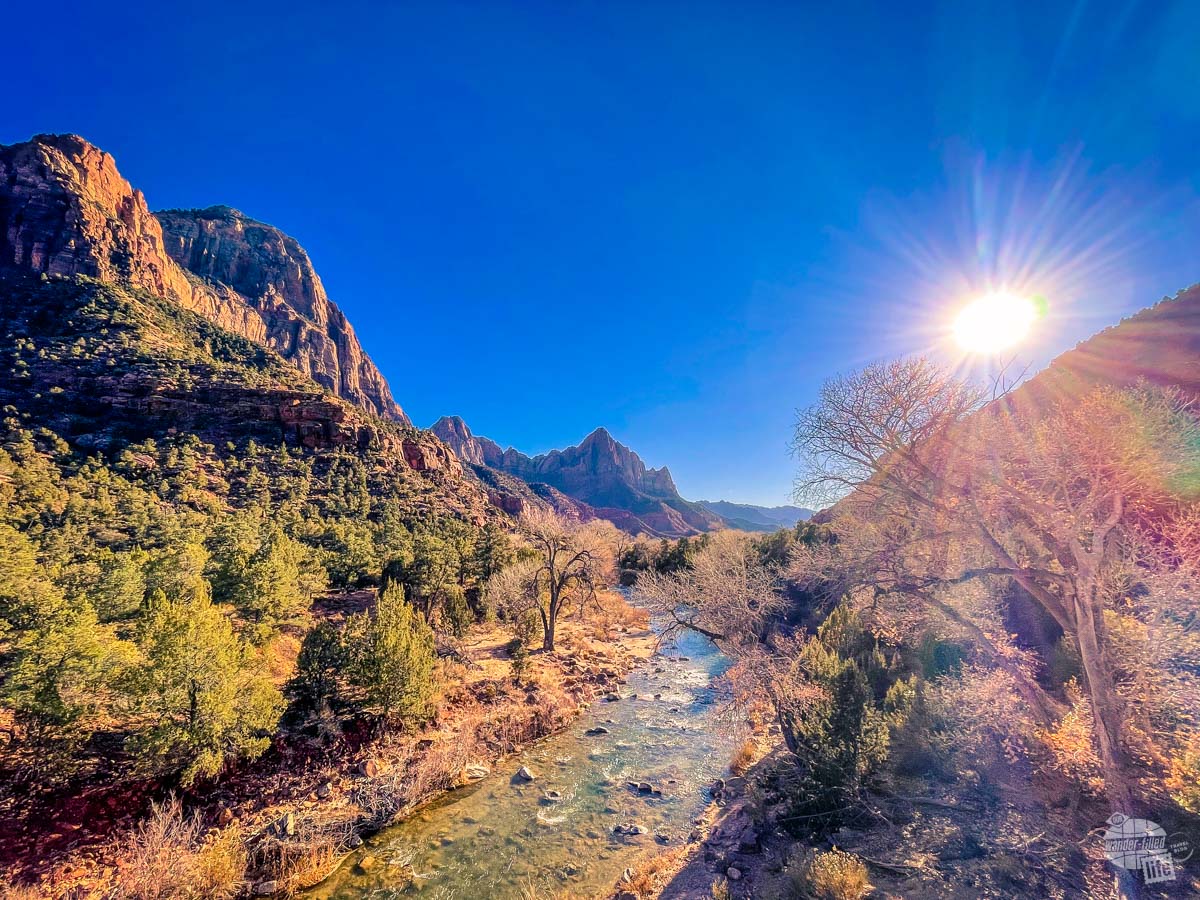
If you’re thinking those two trails are the only reason to visit Zion NP, keep reading and we’ll show you plenty of other reasons. Whether you are planning to visit Zion National Park in the winter or during another season, it’s a great park. Do some research ahead of time, though, to ensure you’re ready to truly enjoy all this park has to offer.
(Disclaimer: When we link to places where you can buy our stuff or places we stayed, we are using special codes that earn us commissions on the sales at no additional cost to you. Please see our Review Policy for more information.)
An Overview of Zion National Park
Zion Canyon is where you will find most of the iconic views and visitor services. This is also where you’ll find most of the people and congestion. The canyon is narrow, with the road running alongside the Virgin River below towering cliffs on either side. You’ll find a few turnouts and parking areas along this scenic drive, which is roughly 10 miles.
During most of the year, though, visitors cannot drive into Zion Canyon. Most people will rely on the park’s shuttle system. Bicycles are also popular, with several rental options in the gateway town of Springdale. You can also walk along the road or the many hiking trails.
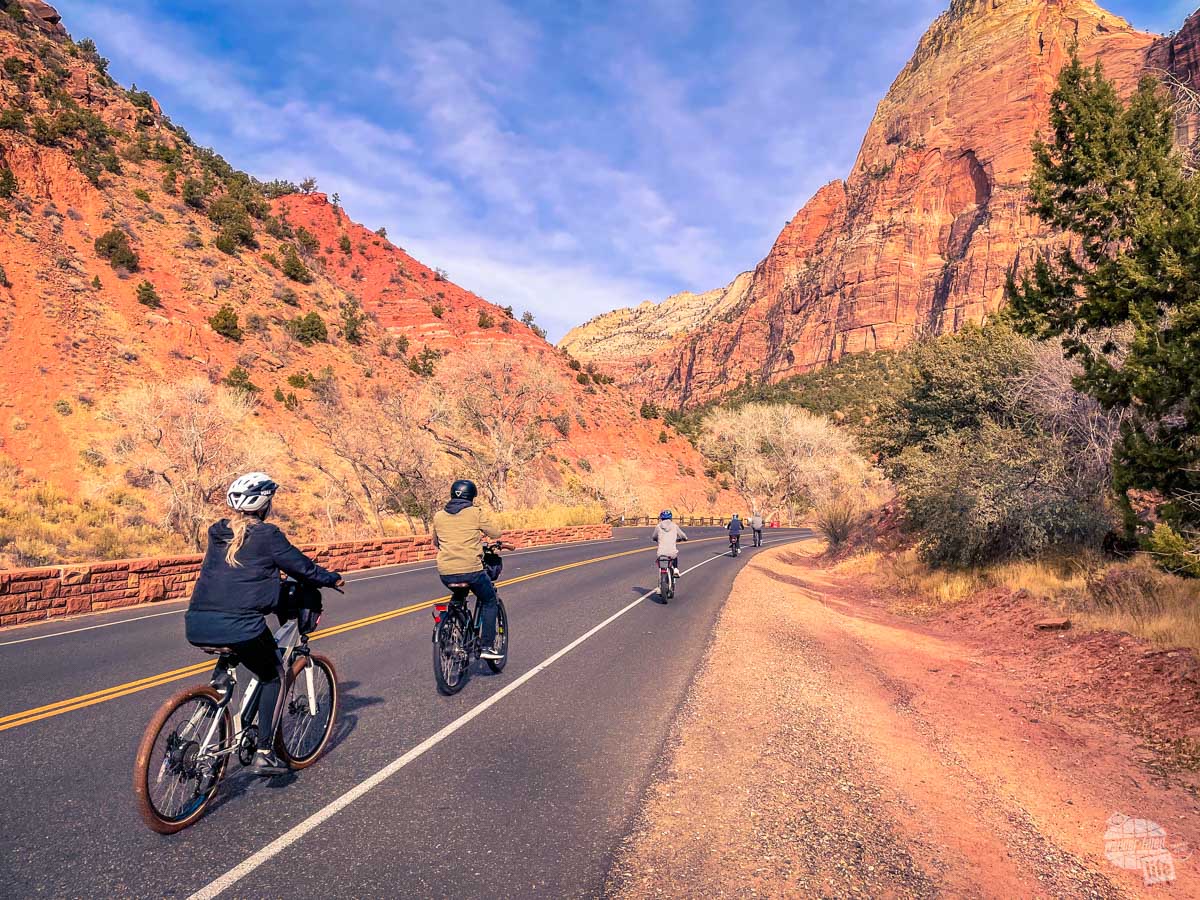
While the canyon is impressive and certainly deserves its popularity, there are other areas of the park that are well-worth visiting.
Instead of turning into the canyon from the main visitor center, you can continue east on Highway 9 for a fantastic drive to the east entrance of the park. Heading east, you’ll have to pass through the 1.1-mile Zion-Mount Carmel Tunnel. If driving an RV, be sure to check the tunnel restrictions. Oversize vehicles are only permitted to pass during certain times, with a permit.
About 30-45 minutes north of the main entrance is the Kolob Canyons area of the park. This remote area boasts some great views and several hiking trails. It is also much less crowded. Check conditions if visiting Zion National Park in the winter, as Kolob Canyons Road may close due to winter weather.
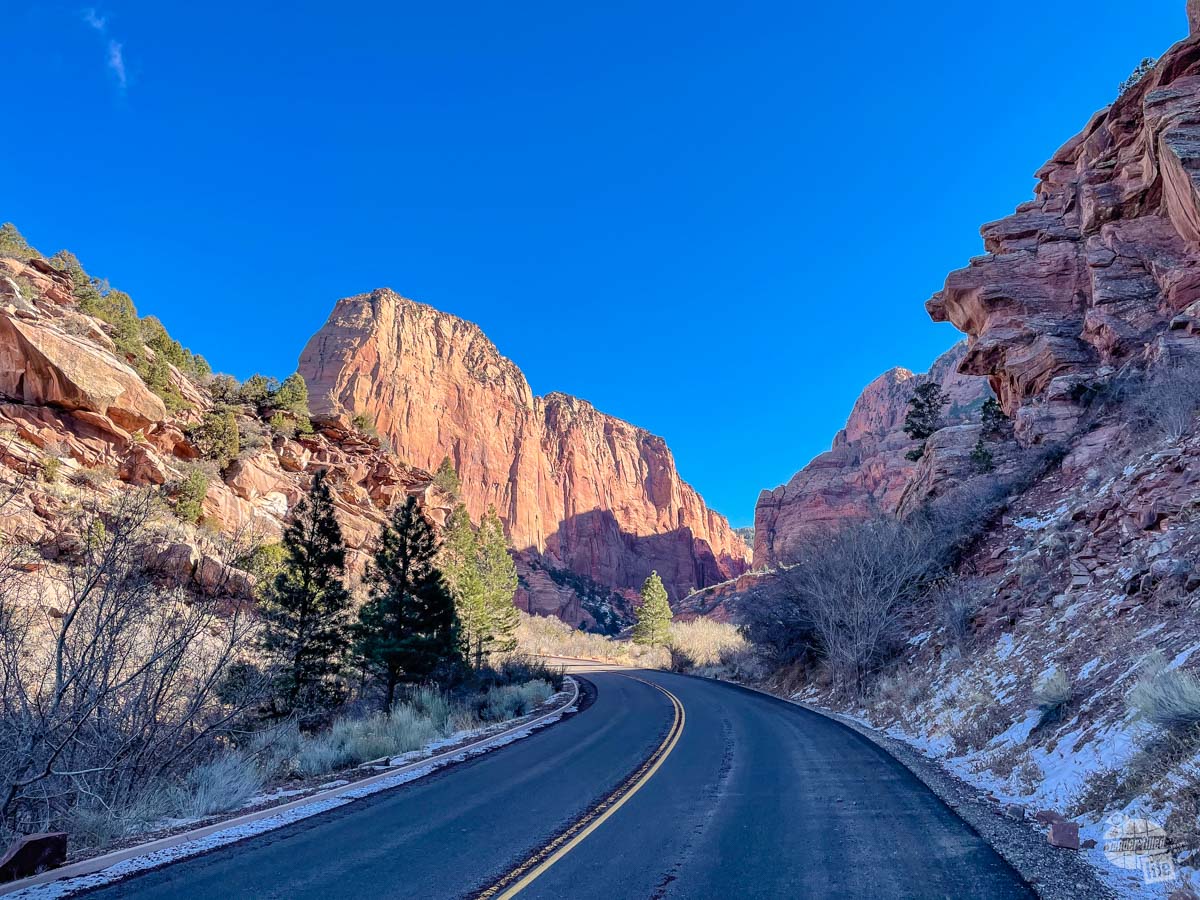
Kolob Terrace Road is a scenic drive just 10-15 minutes west of the main entrance of the park. You’ll find several hiking trails along the road as it climbs more than 4,000 feet to Kolob Reservoir.
Zion Canyon Scenic Drive
Ironically, one thing you won’t find us telling you to do is to enjoy the Zion Canyon Scenic Drive. That’s because most of the year the road is actually closed to private vehicles.
Due to the limited space and high visitation in the canyon, the park began a shuttle service in 2000. Typically, the shuttle operates from mid-February through Thanksgiving and from Christmas to New Year’s. When the shuttle is operating, visitors cannot drive the Zion Canyon Scenic Drive at any point during the day.
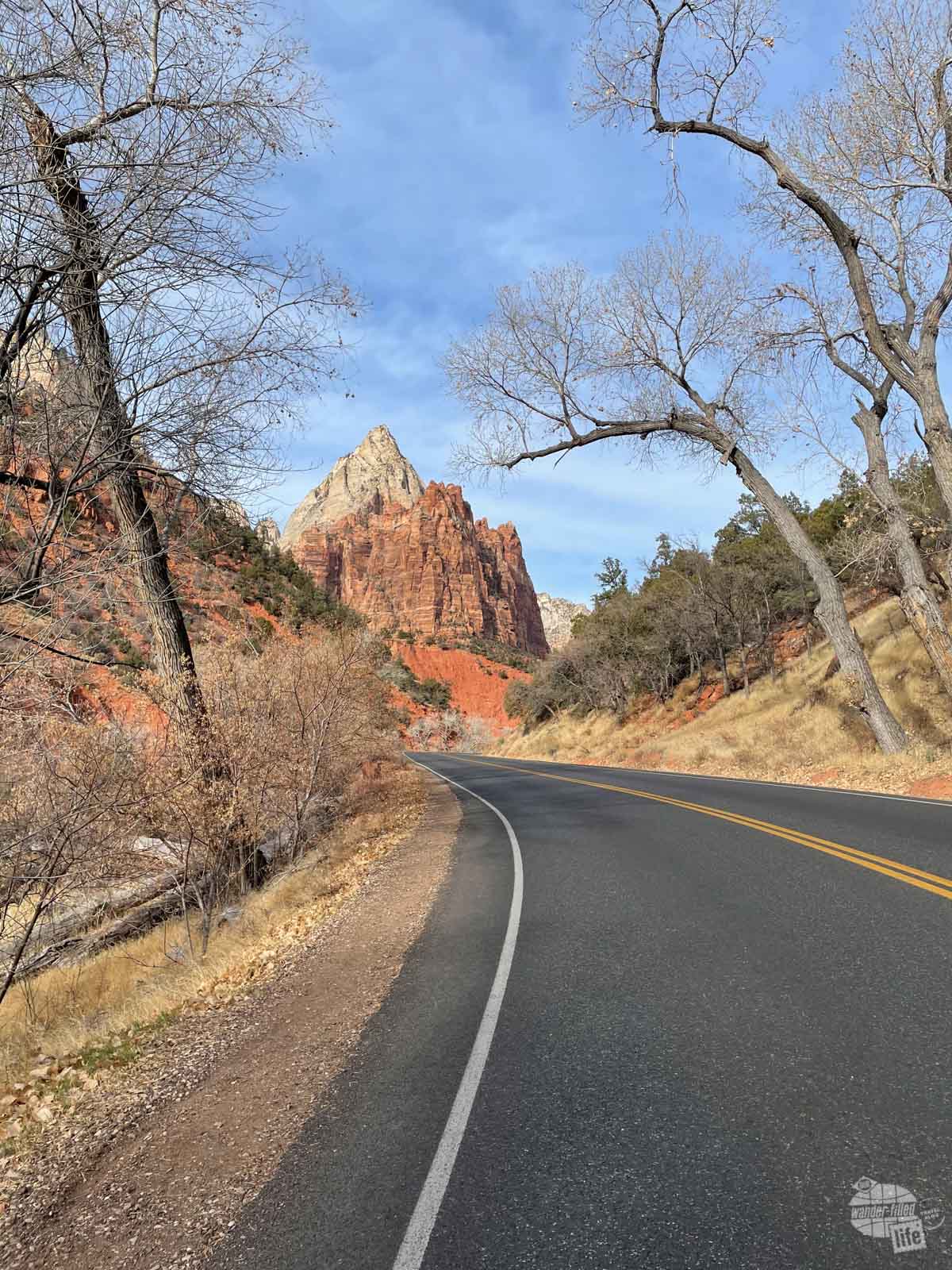
When we visited Zion in December 2020, our first day at the park was the day before the shuttle resumed for the holidays. So, we had one day that we could drive into Zion Canyon. It is important to note that even if the scenic drive in the canyon is open to cars, it will close once the parking areas are full.
If that happens, there are plenty of other things to see and do, though.
Parking in Zion Canyon
I’m going to be honest, we didn’t really realize exactly how limited parking is inside Zion Canyon until we got there. Seriously, it is far less than I ever would have guessed. But, it makes sense because it’s a very tight area.
We entered the park about 8:30 am and headed to the Visitor Center. By the time we spoke to a ranger around 8:45, the scenic drive was already closed. Yep, when they say arrive early, they mean arrive early!
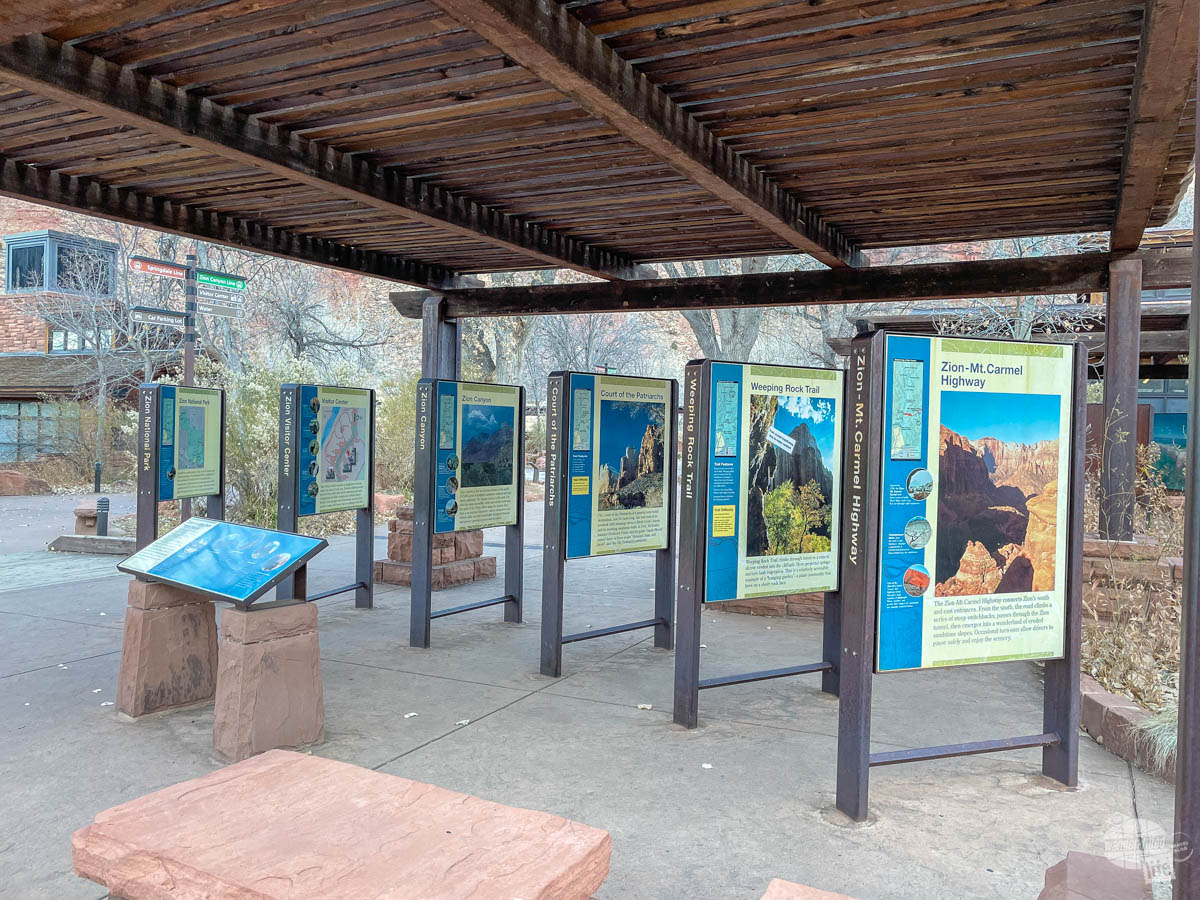
Honestly, though, even if you get a parking space, you likely won’t be able to move your car. Thus, you’re going to be limited to a small area unless you’re willing to do a lot of walking.
Park rangers will open up the scenic drive as parking spaces become available. So, even if it’s full when you first arrive, you may be able to get in later in the day. By about 4:00 we were able to drive in with no restrictions. The only problem was that we were quickly losing sunlight, especially towards the narrow end of the canyon.
Shuttle System
The park shuttle operates in Zion Canyon only. You can still drive all of Highway 9 and get to the other areas of the park if the scenic drive in the canyon is closed. A second shuttle runs through the town of Springdale and drops visitors off at the pedestrian entrance to the park.
In 2020, visitors needed advanced, timed reservations for the shuttle due to COVID-19. Check the park Web site to see if the park will implement tickets again in 2021.

While there is a good amount of parking available at the Visitor Center, I would fully expect it to fill quickly in the busy summer months. If needed, you can use the town shuttle to get from your hotel or campground to the park entrance. There are also several public parking areas in town.
Once on the shuttle, there are several stops along the scenic drive. The stops are at all the major sites and trailheads. Many of the shuttle stops are even connected by hiking trails, allowing you to do some one-way hiking.
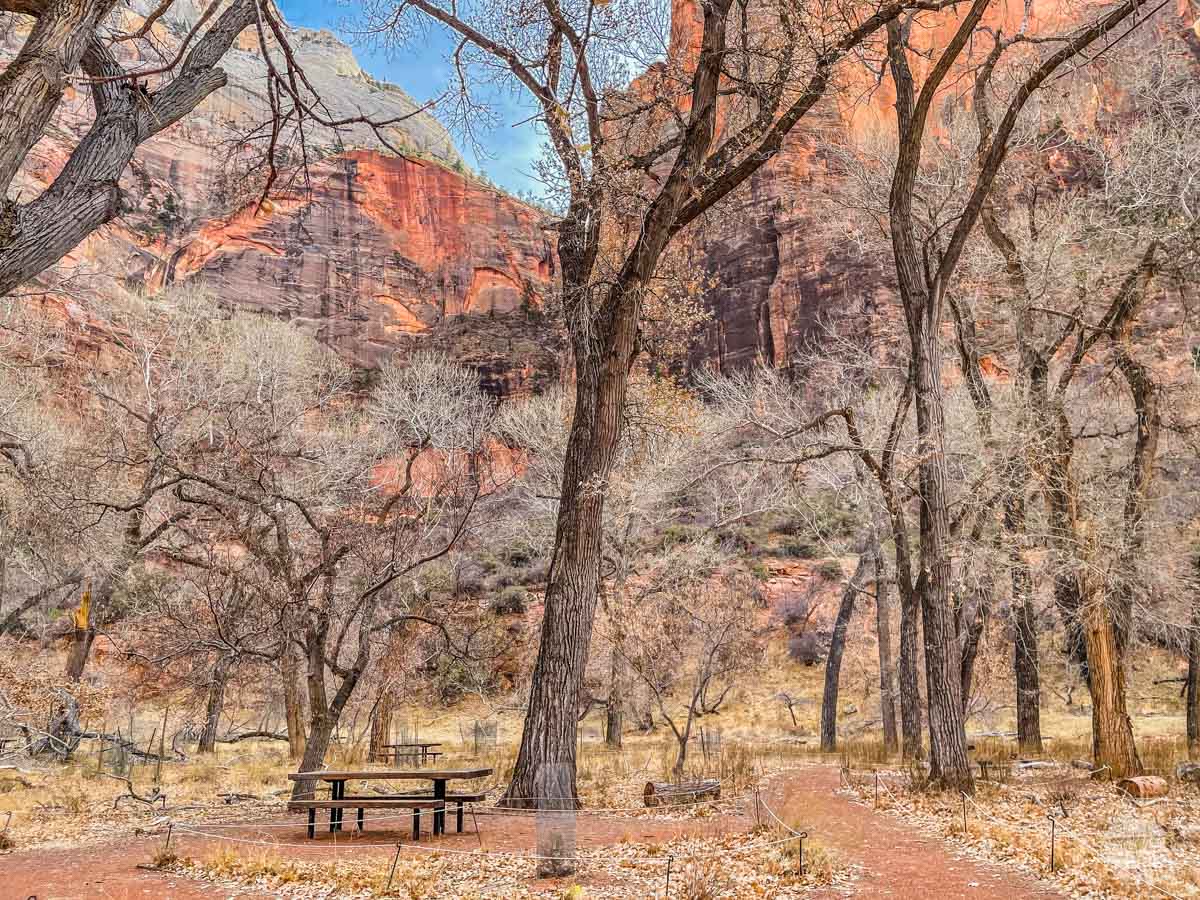
We enjoyed the ease of using the shuttle and certainly can understand its importance in this park. That said, when we visited (December 2020) several of the stops were closed due to a lack of staffing and foot traffic. The biggest problem with the closed stops was the inability to see the Court of the Patriarchs without a long hike and walk along the road.
Hopefully, these shuttle stops will be fully opened for visitors in 2021.
Hiking in Zion Canyon
With only a few roads at Zion National Park, you really do need to get out on the trail to see most of the park. That is definitely true in Zion Canyon. Thankfully, there are plenty of hiking trails of varying levels of length and difficulty for you to choose from.
Check out our 10 essentials for hiking here | Read more about hiking in the winter here
We started our day by taking the shuttle all the way to the end of the road to the Temple of Sinawava shuttle stop and then gradually worked our way out of the canyon.
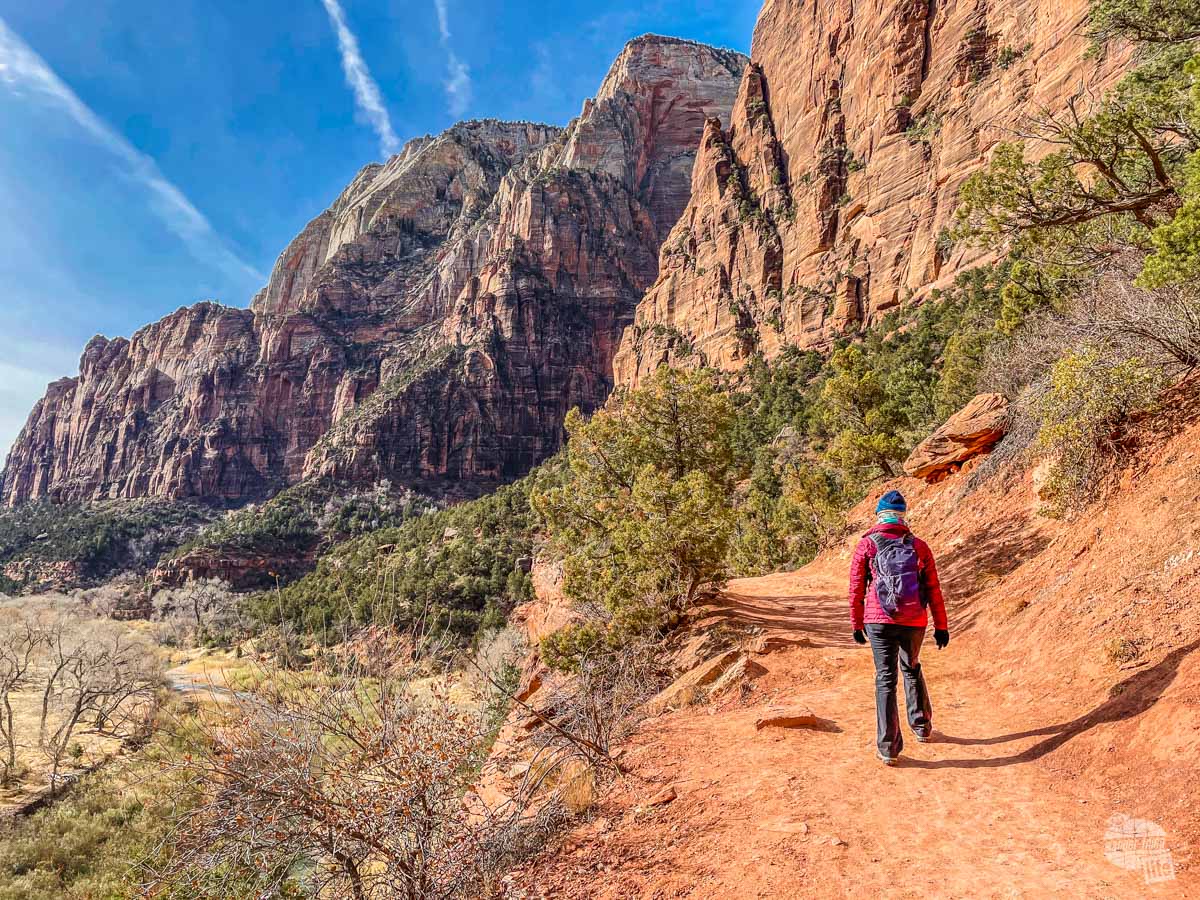
The Narrows and Angels Landing
In Zion Canyon, you’ll find the two best-known trails in the park: The Narrows and Angels Landing. Many people come to Zion NP just to hike these two trails. As previously mentioned, we did just the opposite: we did not hike either of them.
Still, I am including the basics of each hike to explain why we chose to skip them.
The Narrows is a hike through the narrowest part of Zion Canyon, much of which is actually IN the river. That’s right, the river basically is the trail. If you’re visiting Zion National Park in the winter, you’ll need a dry suit to hike The Narrows because the water is extremely cold.
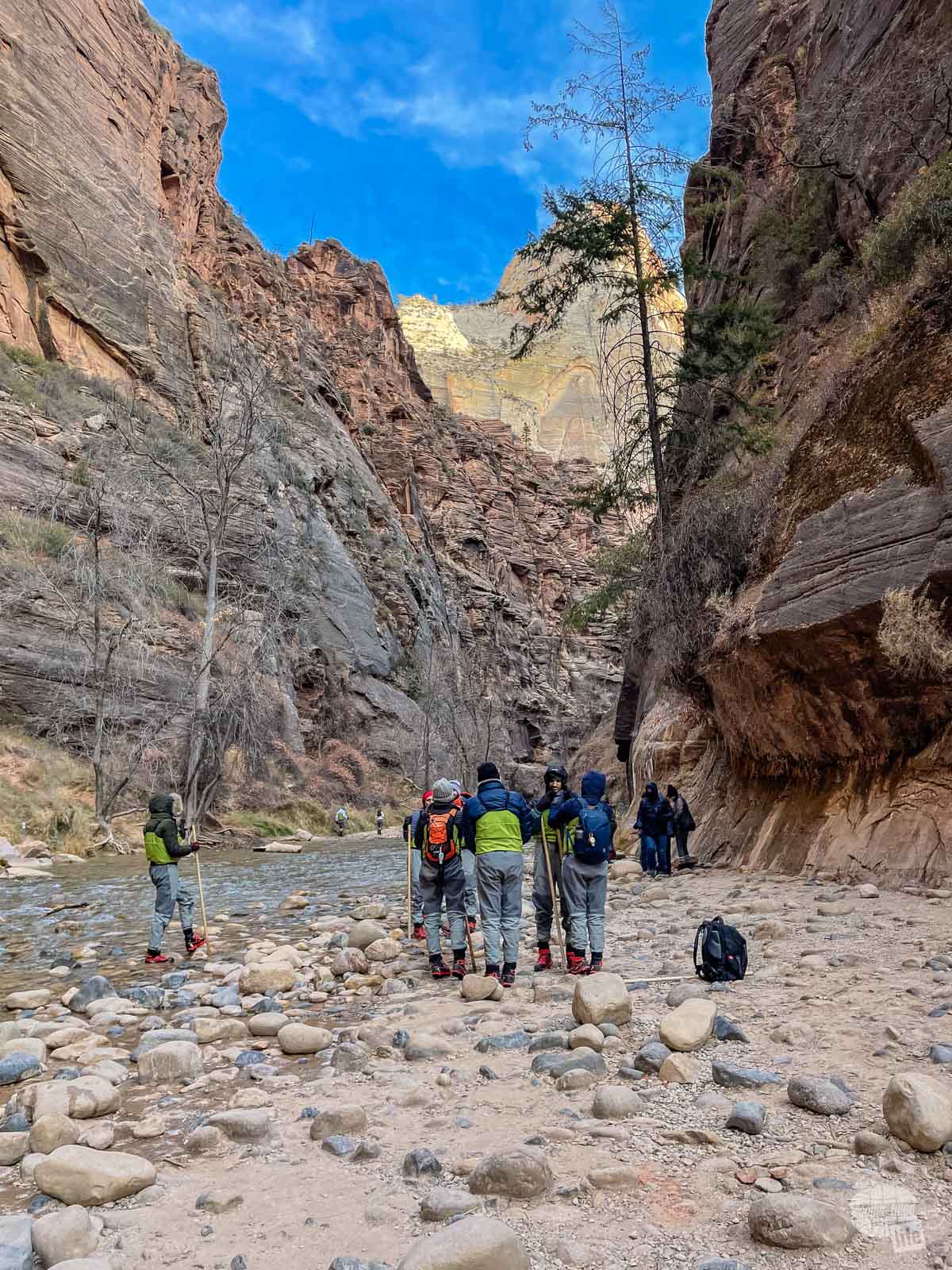
While we certainly hope to make this iconic hike one day, we just weren’t up for doing it in December in freezing cold water.
Angels Landing is a hike up to a viewpoint 1,500 feet above the canyon floor, with incredible views of the canyon. The catch is that the last part of the trail climbs a narrow ridge with drop-offs on either side.
Trail descriptions and reviews say that the strenuous climb is well worth the views. They also warn that the hike is not suitable for anyone with a fear of heights. That’s me. As much as I really want to do this hike, I just don’t think I should. Heights and a narrow trail are exactly the combination that sounds like it would send me into a panic attack.
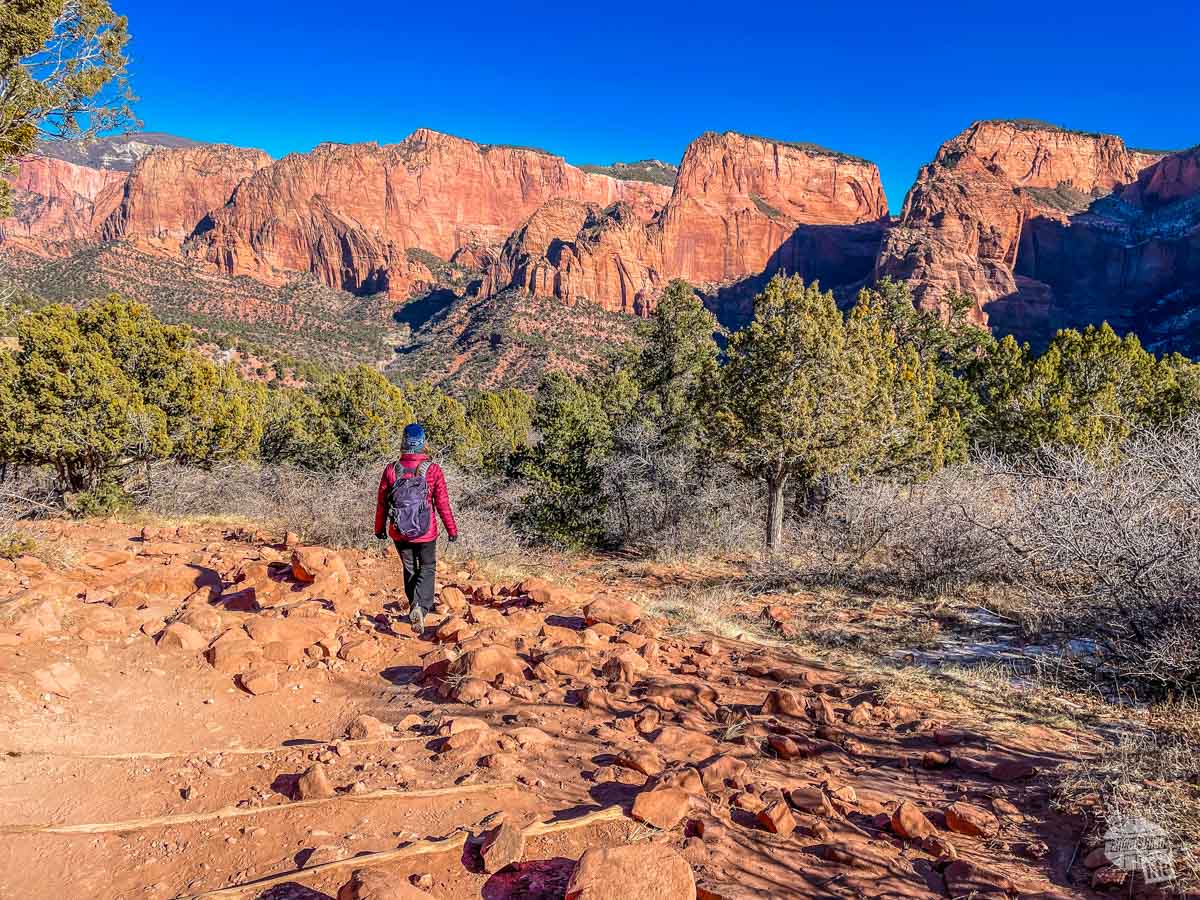
I’ll admit that both of these hikes sound fantastic and worth their status as the most popular hikes. Still, we enjoyed our visit and found plenty of other things to see and do in the park.
Riverside Walk
The Riverside Walk is a 1-mile paved trail along the Virgin River that is the start of The Narrows hike. This is a great choice if you don’t want to hike in the river but still want to see this part of the canyon. The trail has very little elevation gain and is suitable for almost everyone. The first part of the trail is even wheelchair accessible.
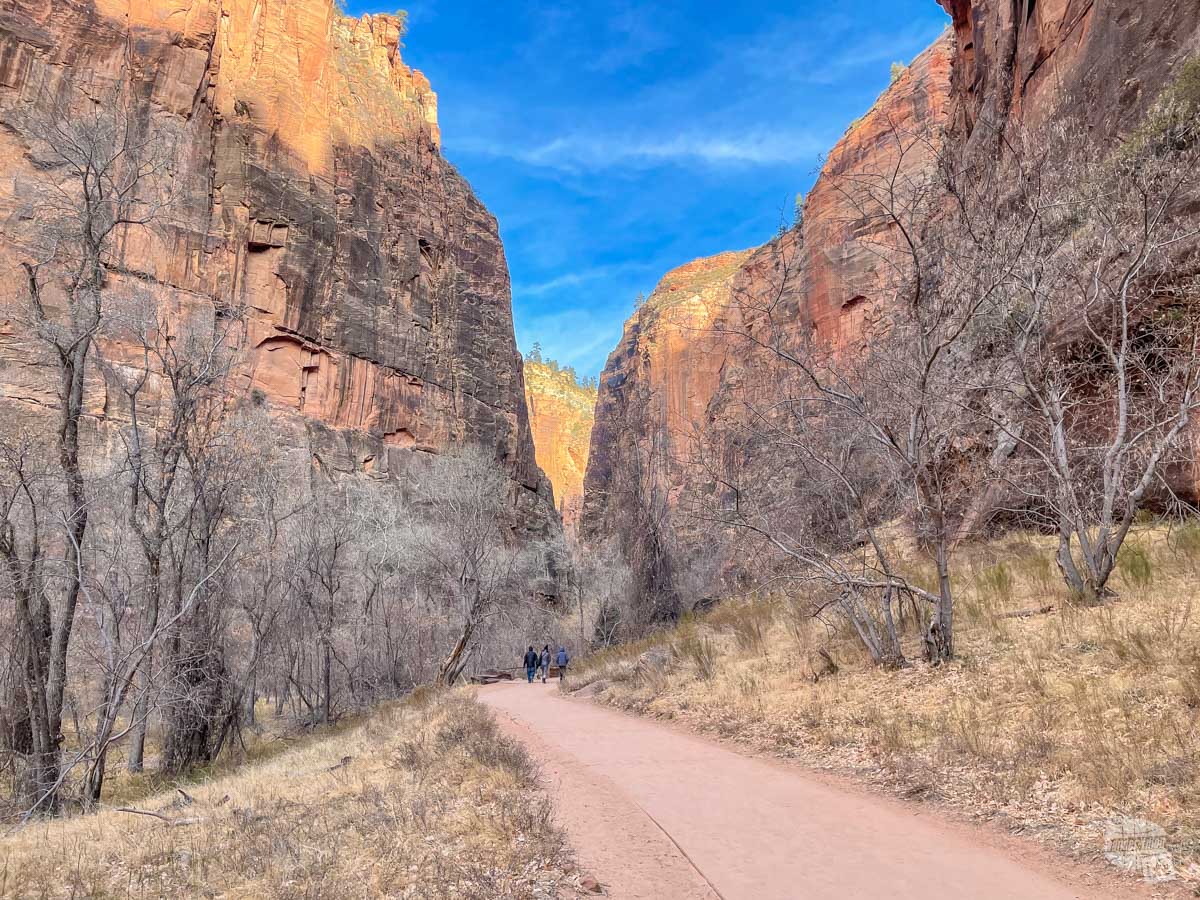
If you stay on the paved trail, you’ll hike right along the canyon walls. In the winter, watch out for ice. Due to the steep canyon walls, this part of the canyon does not get a lot of direct sunlight. Thus, you’ll find more icy spots here than in the rest of the canyon.
There are plenty of places along the trail where you can get down to the river. You’ll even find a secondary trail right along the water in many places.
The best part is that the trail ends right at the river and you can watch folks head out into the river to hike The Narrows.
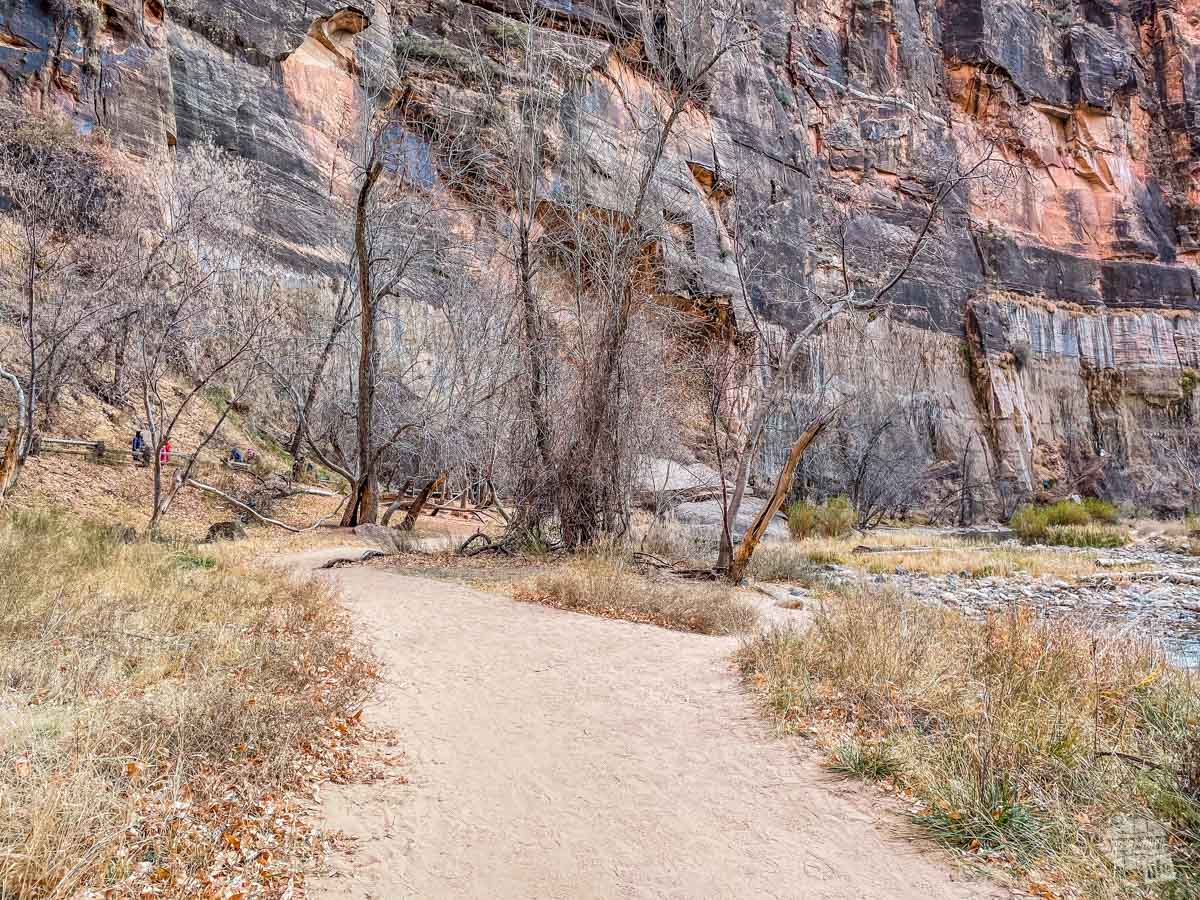
Kayenta Trail and Emerald Pools
The Emerald Pools can only be reached by hiking. Lower Emerald Pool is the easiest to reach. The hike from the Zion Lodge shuttle stop is mostly flat and easy. For a bit more of a challenge, you can also access the Emerald Pools from the Kayenta Trail.
In addition to Lower Emerald Pool, you’ll find Middle Emerald Pool near the junction for the trail to Upper Emerald Pool. All of the pools can be reached from the Lower or Middle Emerald Pool Trail, starting at Zion Lodge or the Kayenta Trail, starting at The Grotto. The trail to Upper Emerald Pools is about one mile out-and-back from the junction near the Lower Emerald Pool Trail and the Kayenta Trail.
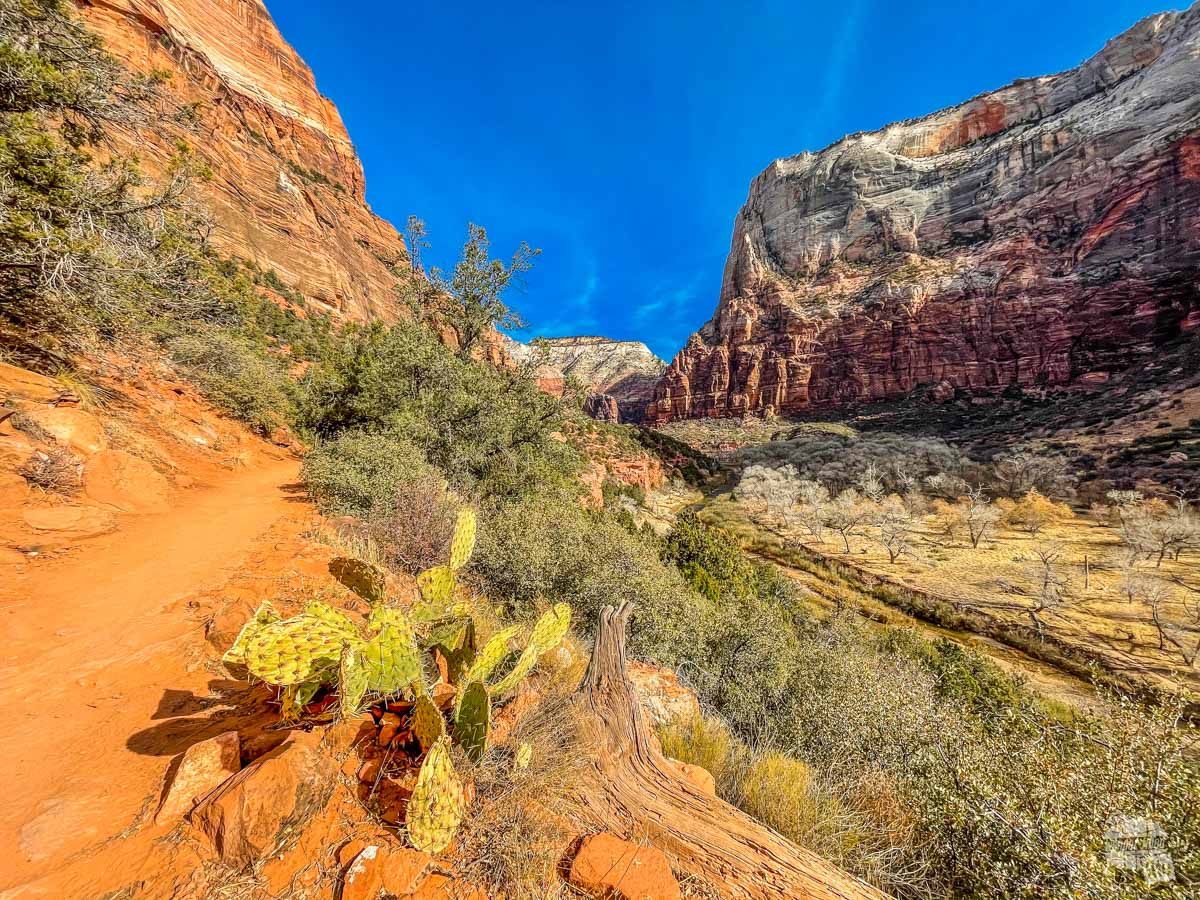
We started our hike at The Grotto, following the Kayenta Trail for about a mile to the turnoff for the Upper Emerald Pool Trail. Out and back to Upper Emerald Pool is certainly the most strenuous part of the hike. After returning to the trail junction, we headed down to Lower Emerald Pool and followed that trail back towards Zion Lodge. Altogether, this was about 2.4 miles and took us about 1.5 hours.
If you wanted to turn this into a full loop, you could take the mostly flat Grotto Trail from Zion Lodge back to The Grotto. Of course, you can easily start the loop at Zion Lodge as well.
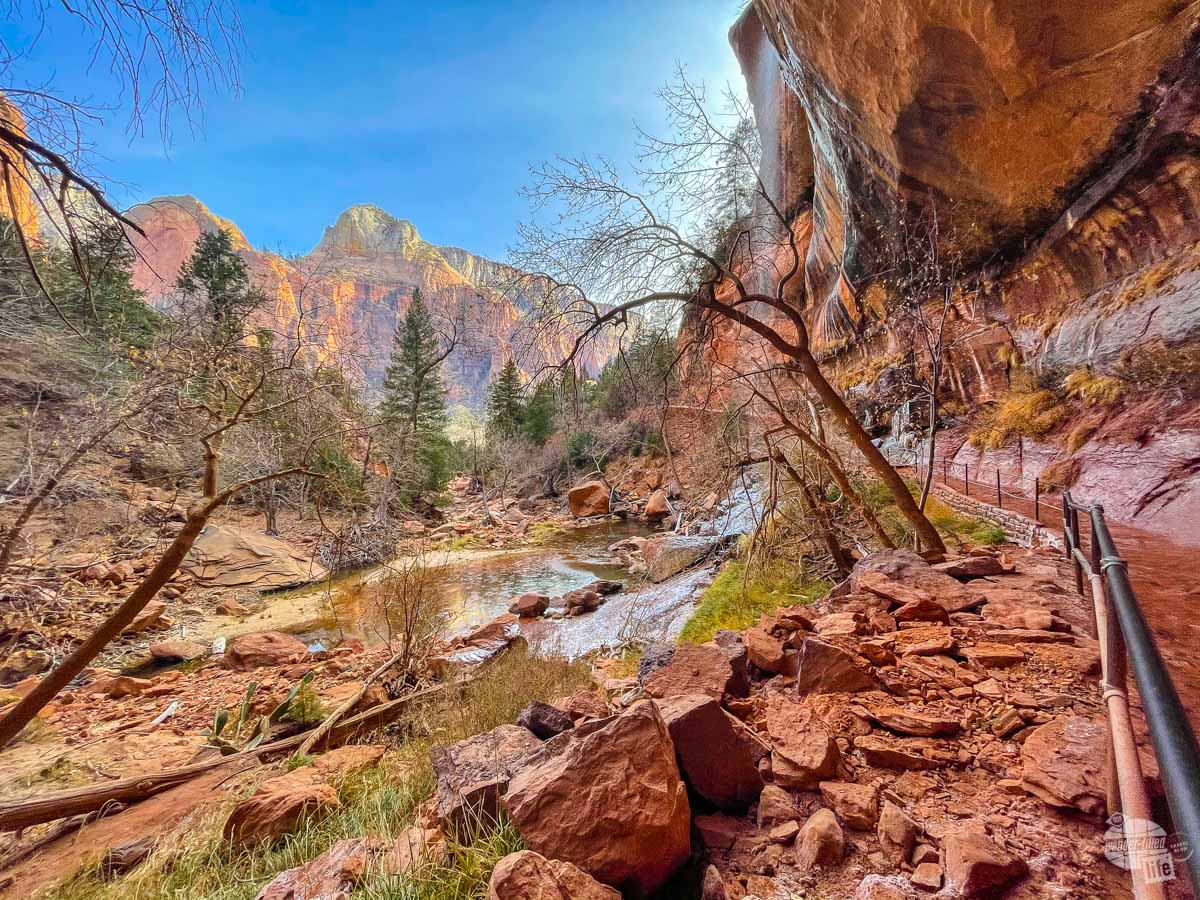
Trail Options
What we enjoyed most about the Kayenta Trail is that it is just high enough above the canyon floor to have some remarkable views. At the same time, it is not too strenuous. The Lower Emerald Pool trail did not have quite the same views but was a bit easier of a trail.
The waterfall at Lower Emerald Pool is quite nice. There wasn’t a lot of water flowing in December but it was still worth the hike. In the winter, ice can be a problem along this trail. In fact, there was one section where we had to use the railing to pull ourselves up a small incline because there was so much ice on the trail. Definitely check the conditions in the winter before heading out on the trail.
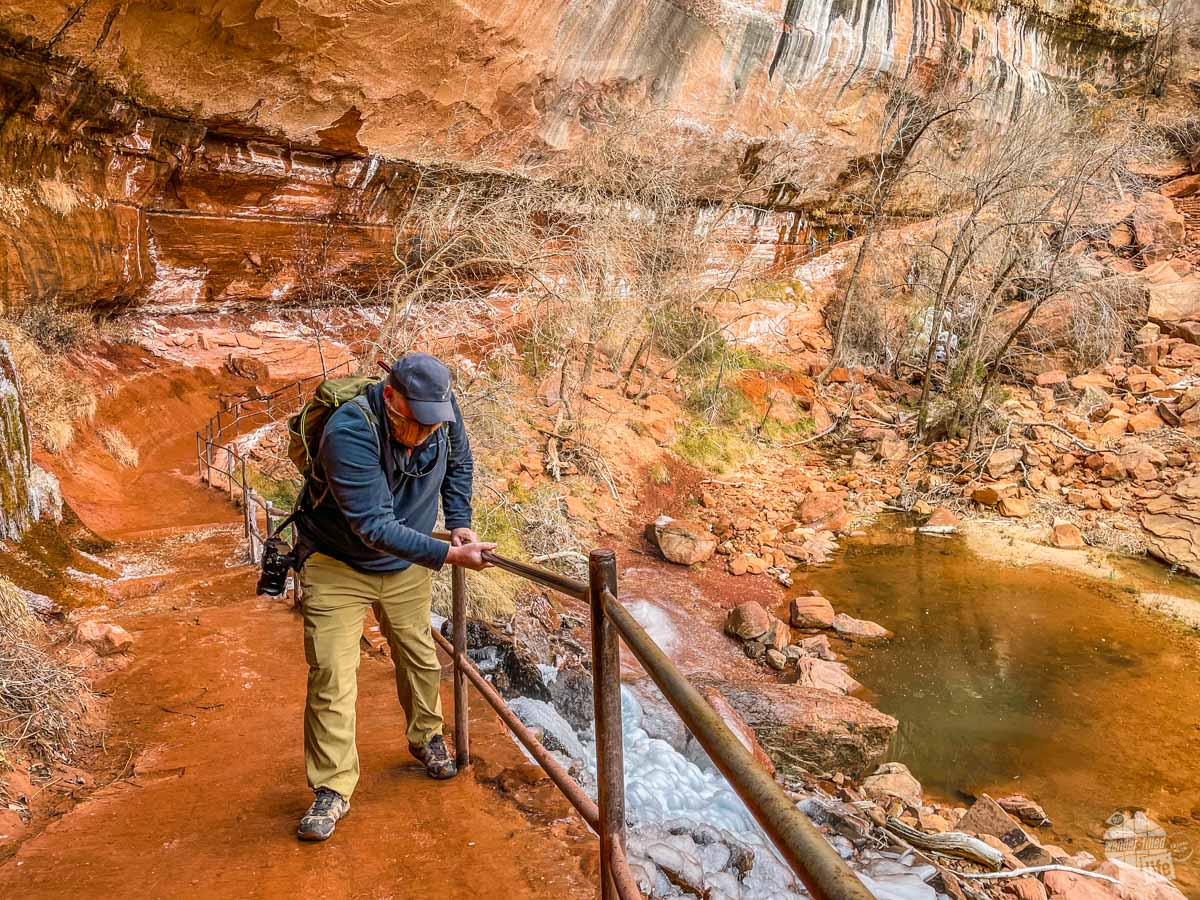
Upper Emerald Pool is a nice hidden pool of water at the base of a cliff. You’ll find a good amount of space to sit and relax or maybe enjoy a picnic lunch. If you don’t have the time or stamina to make the hike up, you won’t be missing much, though.
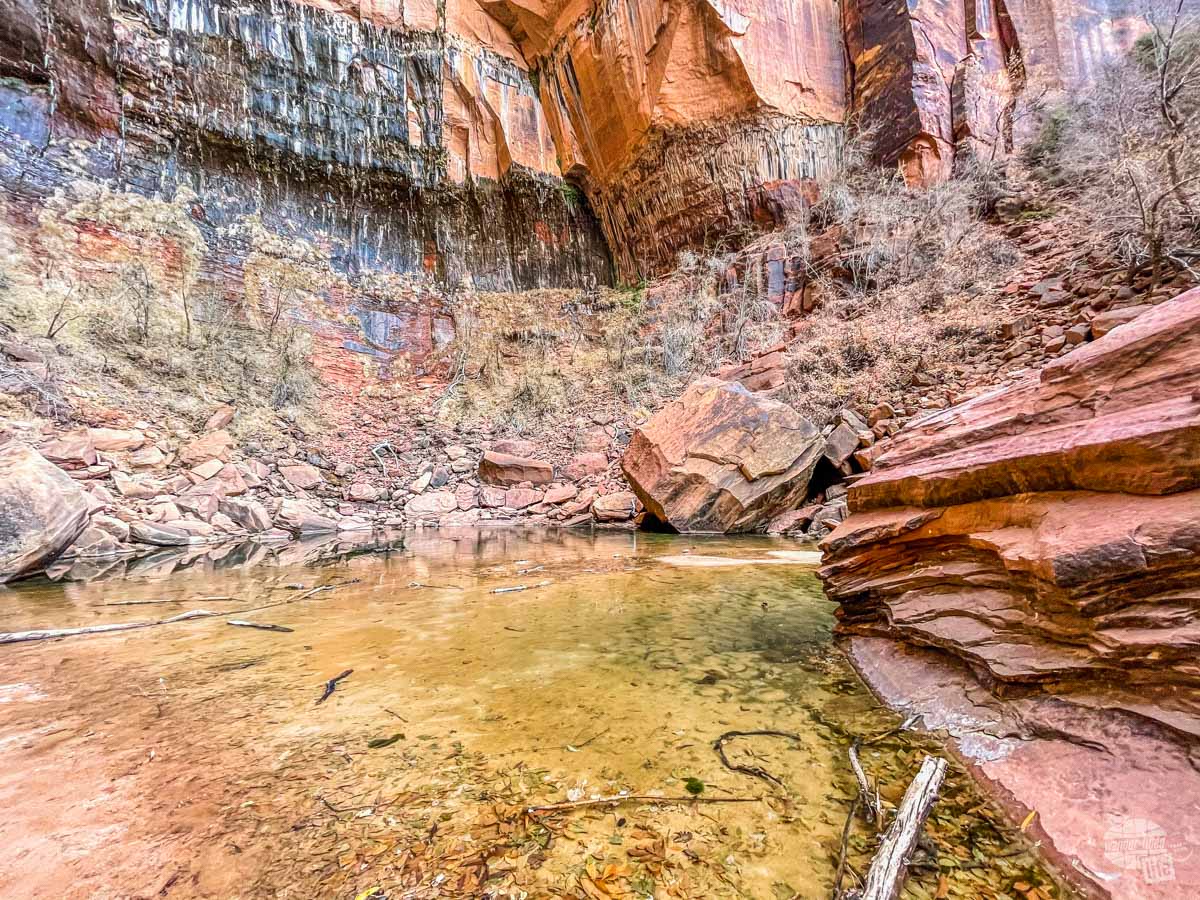
Overall, this is a great hike with lots of variations. You can do it as an out and back from either The Grotto or Zion Lodge. Or you can do it as a loop between the two stops. Add on the trail to the Upper Pool only if you want to. You really make this trail whatever you want it to be.
Sand Bench Trail (Zion Lodge to Court of the Patriarchs)
Most of the time, the shuttle stops at the Court of the Patriarchs. There is also a parking lot here if the scenic drive is open. Unfortunately, when we visited this shuttle stop was closed. So, for us to see this magnificent view, we had to use our feet.
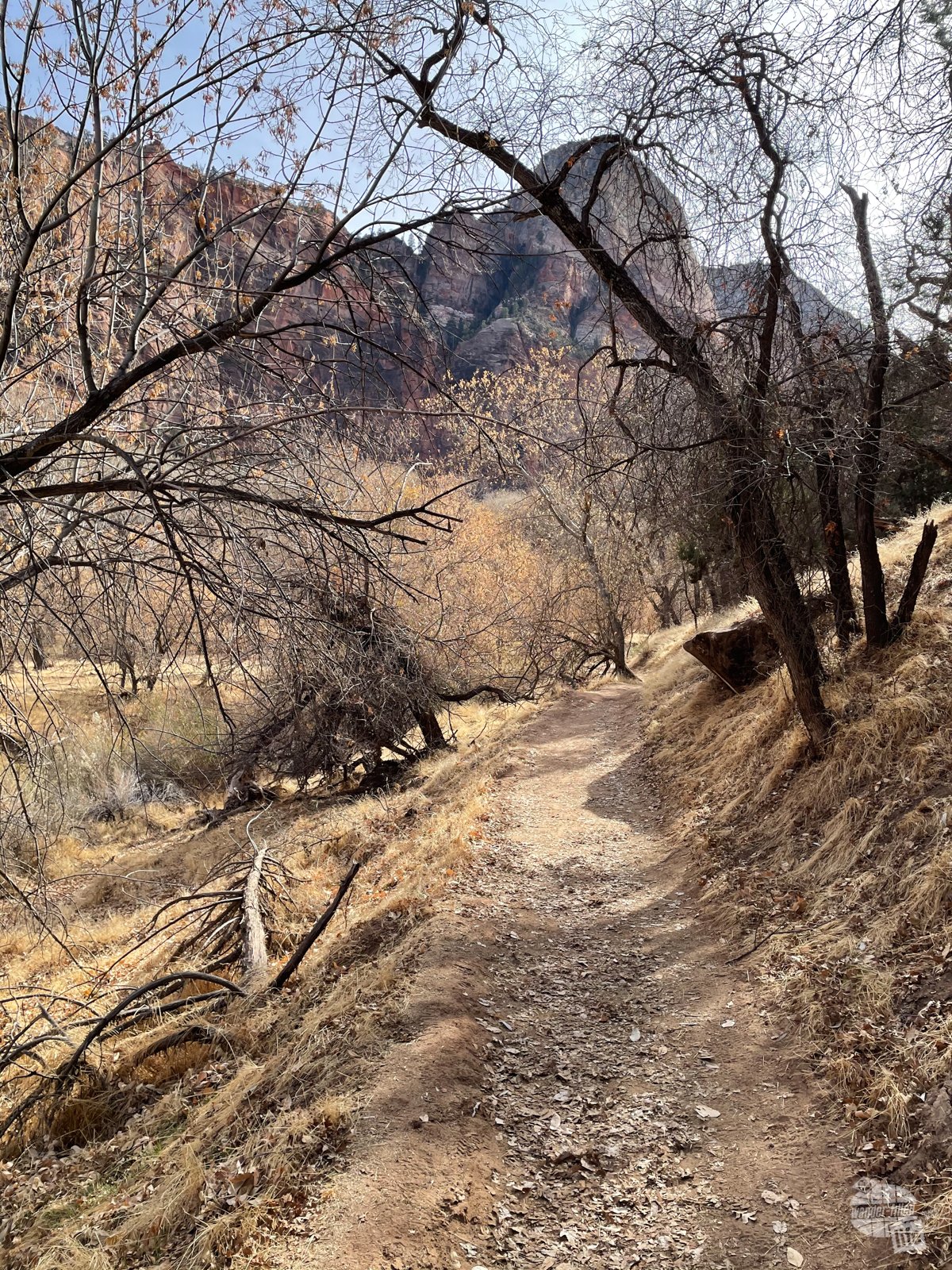
After hiking from Lower Emerald Pool toward Zion Lodge, we continued south on the Sand Bench Trail. I have to say, this was perhaps the best part of our day, as we did not see a single person on this trail until we were at Court of the Patriarchs. And we only saw one person there. Of course, I would expect this to be different in the summer or if the shuttle stop was open.
I’ll be honest, we were originally a little hesitant to hike a trail with the word “sand” in it. After visiting a lot of sand dunes, we really don’t like hiking in sand! Thankfully, this part of the trail, at least, was not too sandy. Any sand we did encounter was well-packed and easy to walk on. We only did a small portion of this trail, though. Once we reached Court of the Patriarchs, we headed toward the road.
At Court of the Patriarchs, you’ll find three peaks known as Abraham, Isaac and Jacob. Just like most of Zion Canyon, these sandstone cliffs are quite impressive!
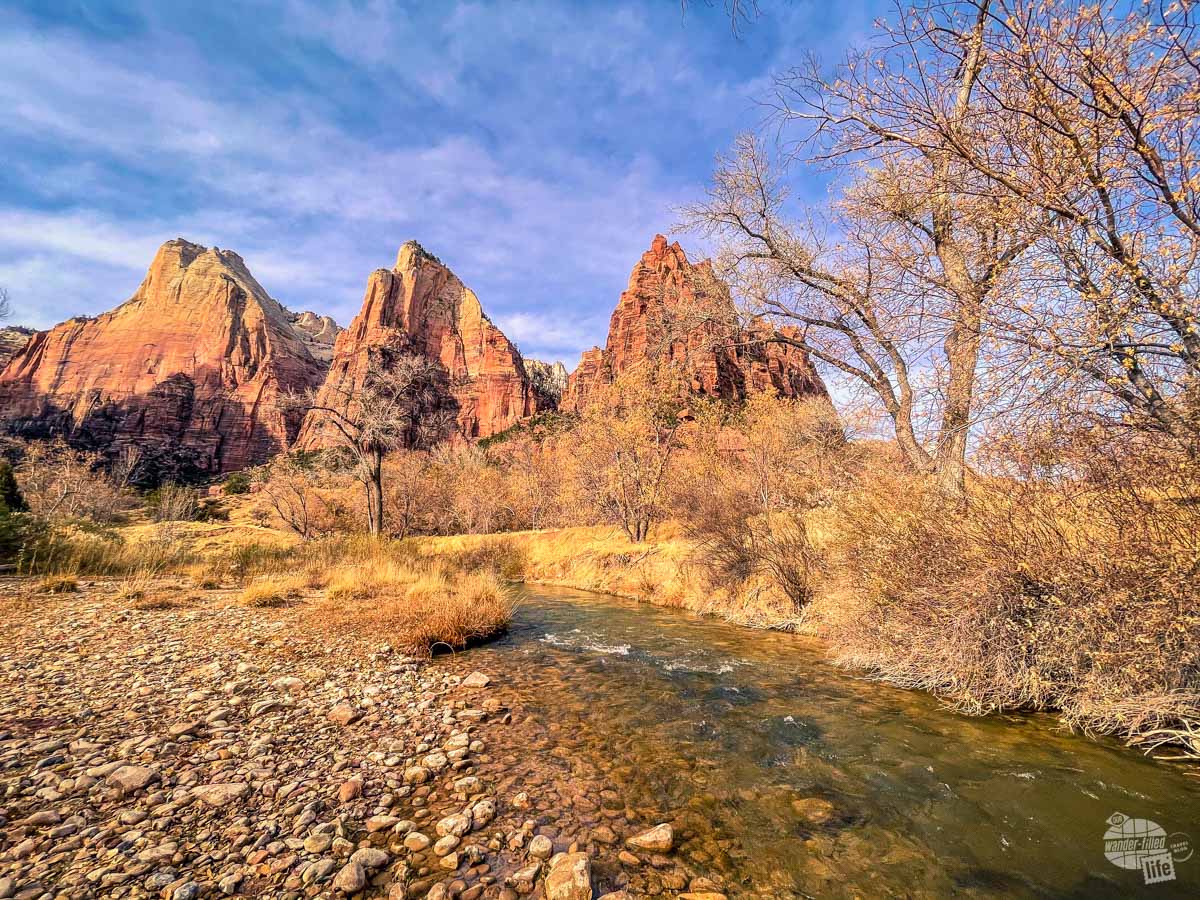
While we enjoyed the trail, there wasn’t anything super special about it. Really, it was just a great way to get between the two shuttle stops and actually see the Court of the Patriarchs. We took about 45 minutes to hike 1.7 miles.
Hiking Along the Road
Without the shuttle, we had to walk along the road to get from Court of the Patriarch to the Pa’rus Trail, which we took back to the visitor center.
Normally, we hate walking along the road. But, with only shuttles and the occasional employee vehicle, it really wasn’t too bad. The road is mostly flat and you’ll have great views pretty much the entire way. Just be sure to step off the road when a bus passes by.
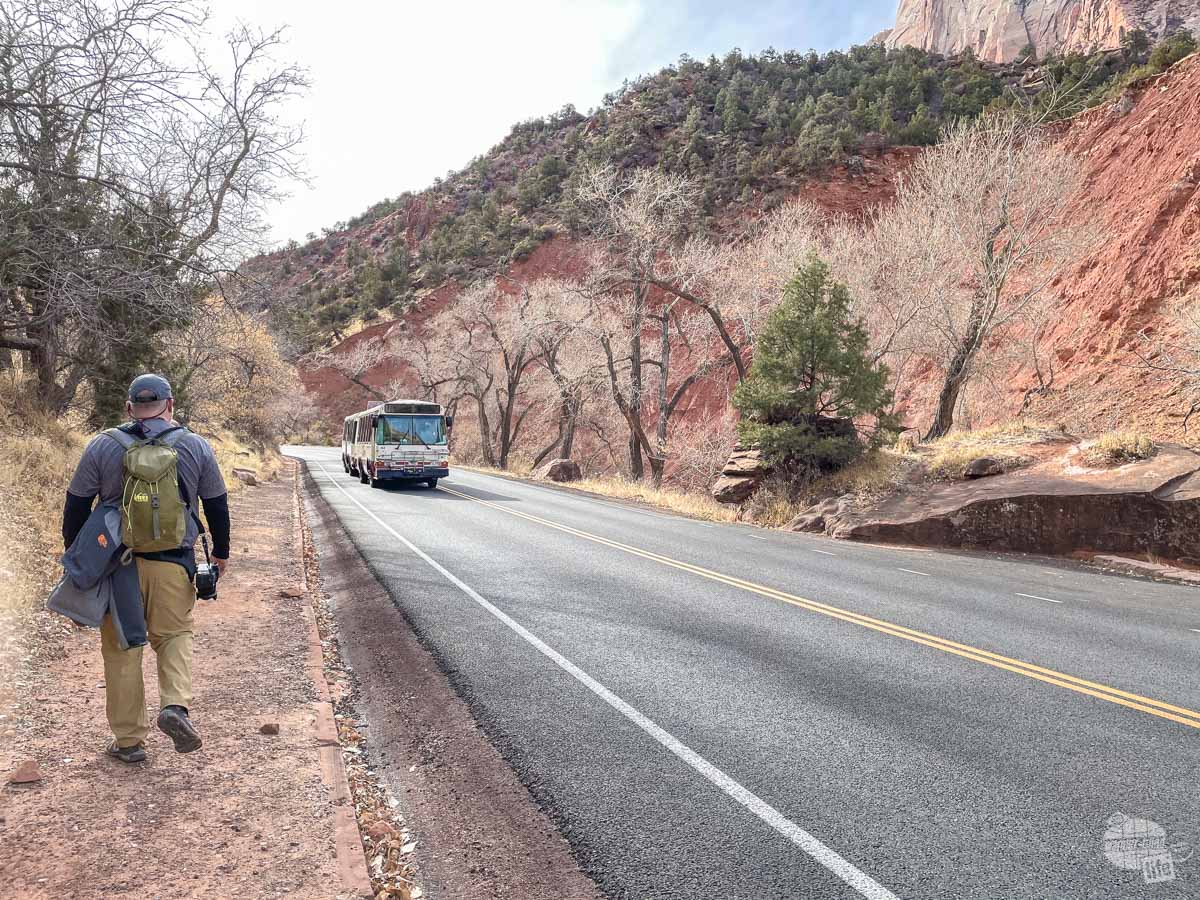
Pa’rus Trail
The Pa’rus Trail is a paved trail along the river that runs from the Visitor Center to Canyon Junction. The mostly-flat trail is nearly two miles one way and is the only trail that allows pets and bicycles.
When the shuttle is running, this is a nice, easy walk between two shuttle stops. It is far enough off the road to not have a lot of road noise. You’ll also have fantastic views of the canyon and river along the entire trail. In fact, the trail crosses the river (via footbridge) several times.
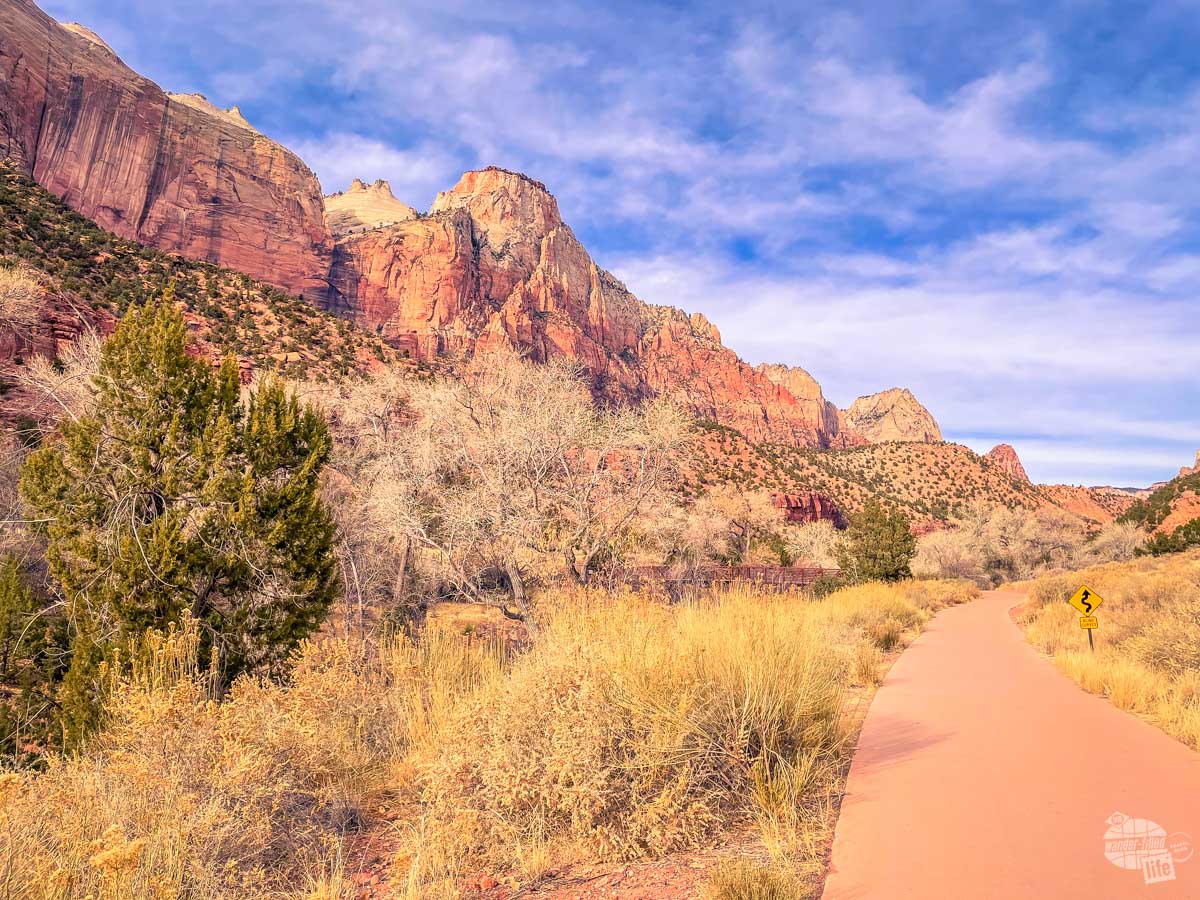
The only complaint we had was that the Canyon Junction shuttle stop was closed. That meant our only options were to do this as a round-trip hike from the Visitor Center or walk along the road north of Canyon Junction. While this hike was nice, I don’t know that it is nice enough to really enjoy as a round-trip.
Again, we hope that the shuttle stops are fully functional in 2021!
Highway 9 Scenic Drive
Heading east on Highway 9 will take you up several switchbacks to the Zion-Mt. Carmel Tunnel. You’ll find turnouts and amazing views along the way. Once you reach the other side of the tunnel, you’re in a completely different landscape from Zion Canyon.
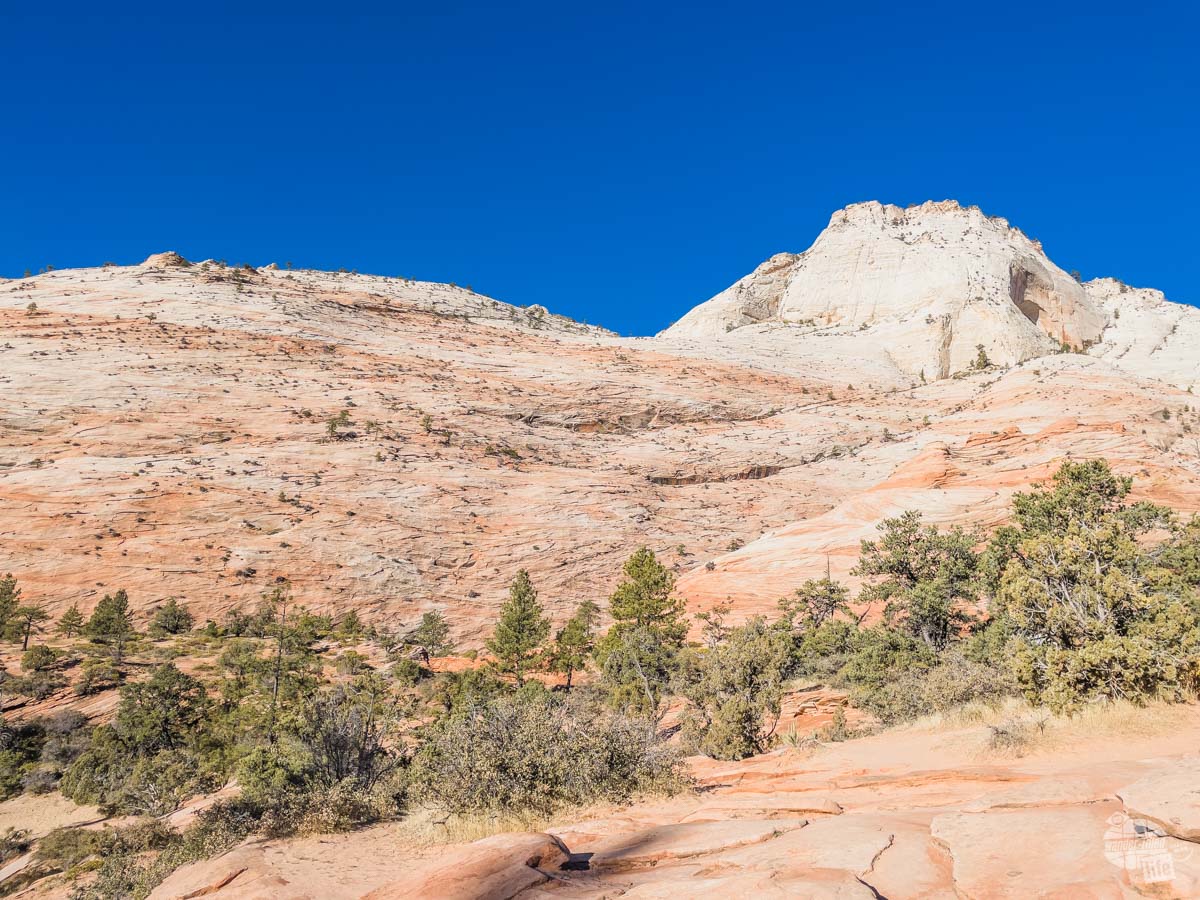
The Canyon Overlook Trail is just east of the tunnel. Right at the East Entrance, the East Rim Trail offers several options for anyone looking for longer, more strenuous hikes.
There are also a number of places where you can park and wander around. We got the feeling that there are several trails in this area that just aren’t advertised by the park service. The next time we visit Zion National Park we are going to invest in a hiking guide book in hopes of finding some of the hidden gems of this park.
We also spotted a few bighorn sheep in this area of the park, not too far east of the tunnel.
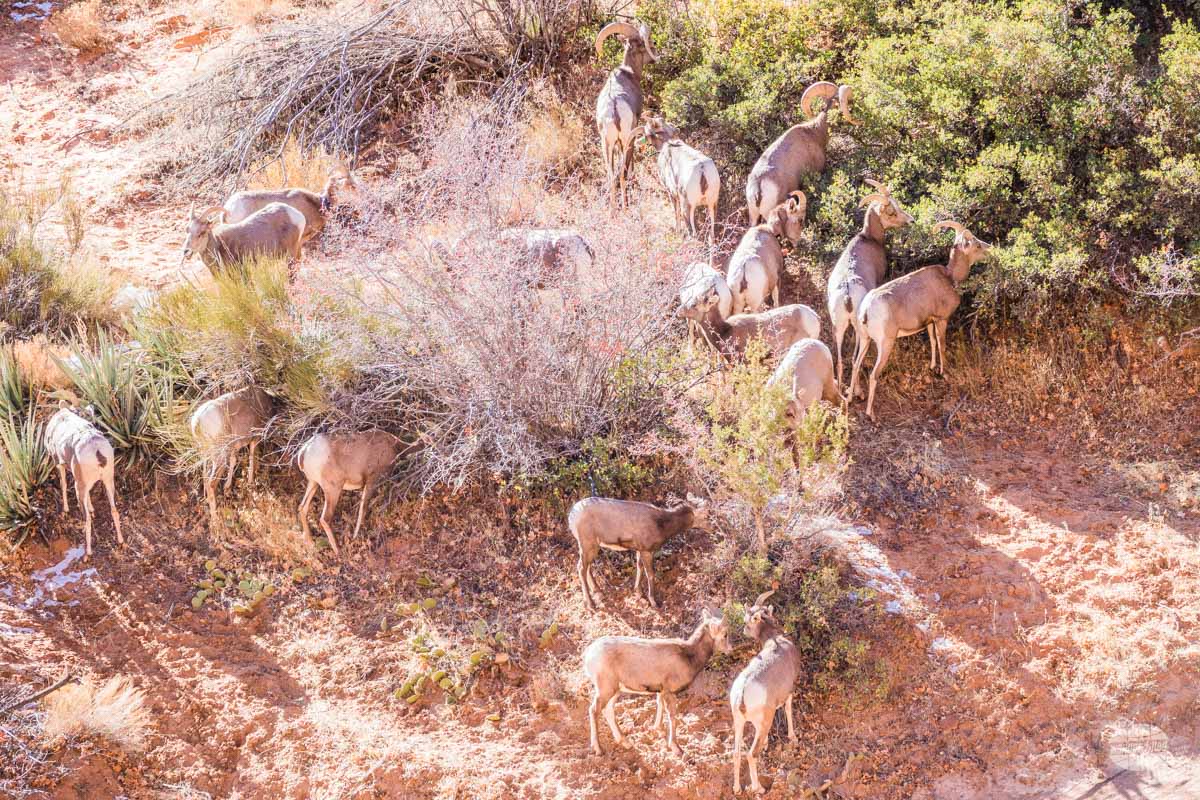
Canyon Overlook Trail
If you’re up for a trail with a few drop-offs and incredible views of Zion Canyon, check out the Canyon Overlook Trail. While there are a few spots along the trail that tested my aversion to heights, overall this is not a bad trail, especially for the incredible views at the end.
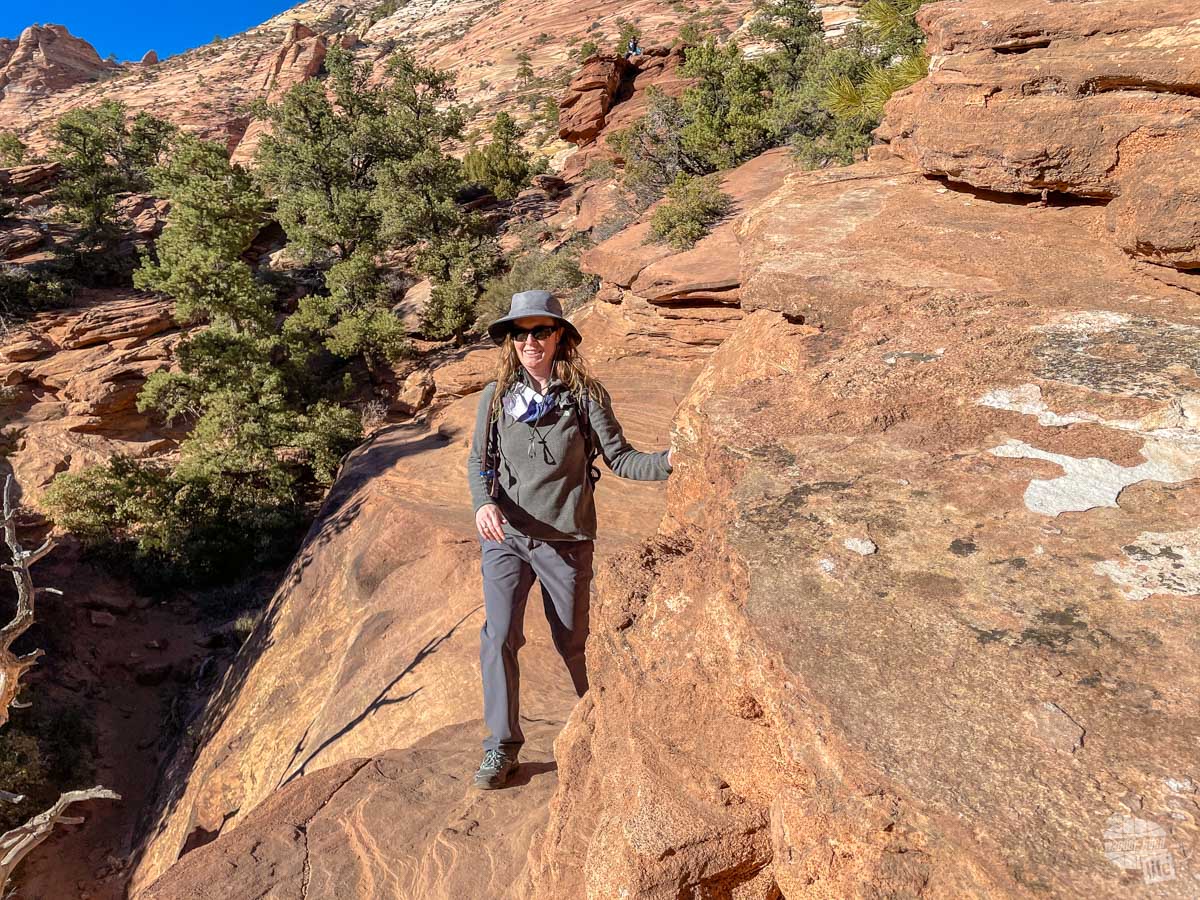
Though not a difficult hike, the trail does gain about 160 feet in elevation and crosses rocky, uneven terrain. The reward at the end, though, is well worth the effort! Seriously, if you want a great view but aren’t up for hiking Angels Landing, the Canyon Overlook Trail is a great alternative.
The trail itself is fairly tight in spots. It is also popular, so you’ll find plenty of people along the way. At the end, though, you’ll have plenty of space to find a spot to yourself. We had to do a little scrambling over the rocks but finally found a spot away from the crowds to just sit and enjoy the view.
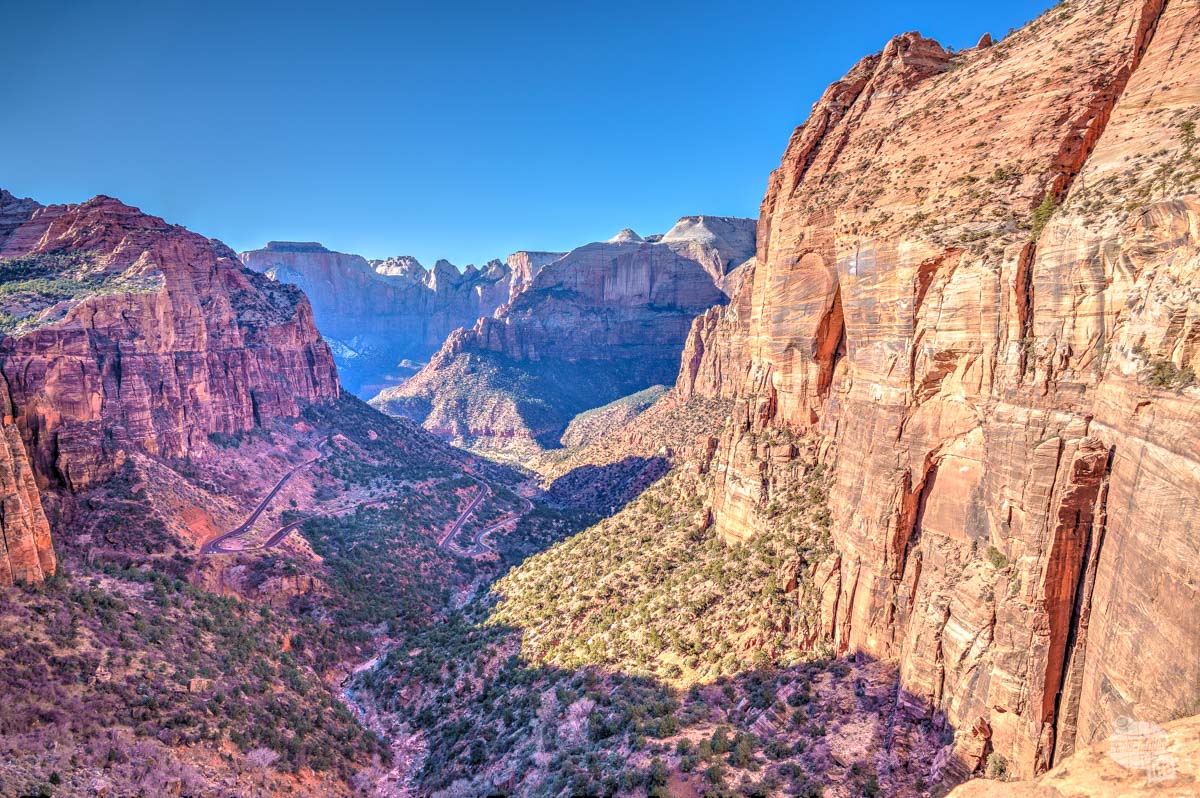
Honestly, the biggest frustration about this hike is the lack of parking. Due to the extremely limited parking, you may have to walk along the narrow road a bit to get to the trailhead. If you see parking relatively close to the trailhead, grab it. If not, enjoy the drive east and try again on your way back west. You’ll likely have the best chances of getting a good parking space first thing in the morning or later in the afternoon.
Kolob Canyons
Located about 30-40 minutes north of Zion Canyon, Kolob Canyons offers more great scenery with fewer crowds. When visiting Zion National Park in the winter, be sure to check the conditions at Kolob Canyons, as the park completely closes the road if there is too much snow.
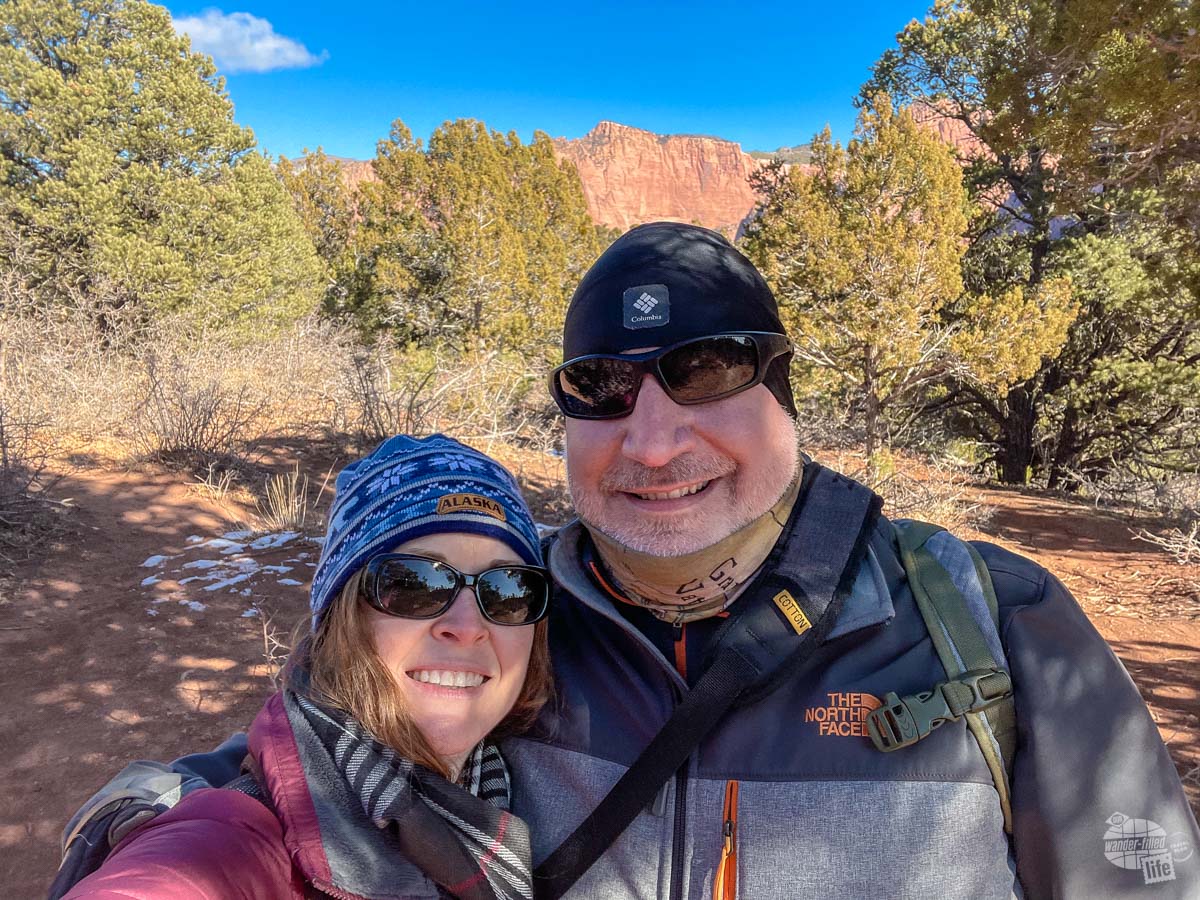
Conditions here do vary greatly from conditions in Zion Canyon. When we visited, temperatures at Kolob Canyons were about 15-20 degrees cooler than Zion Canyon. The road was clear but we did find quite a bit of snow in certain areas.
When the road is open, you’ll find a roughly 5-mile scenic drive with a couple of short and long hiking trails.
Timber Creek Overlook Trail
At the very end of the scenic drive is Timber Creek Overlook Trail. This 1-mile round trip trail follows a ridge to an overlook south into the park. Overall, the trail is fairly easy and definitely worth it for the views along the way and at the end.
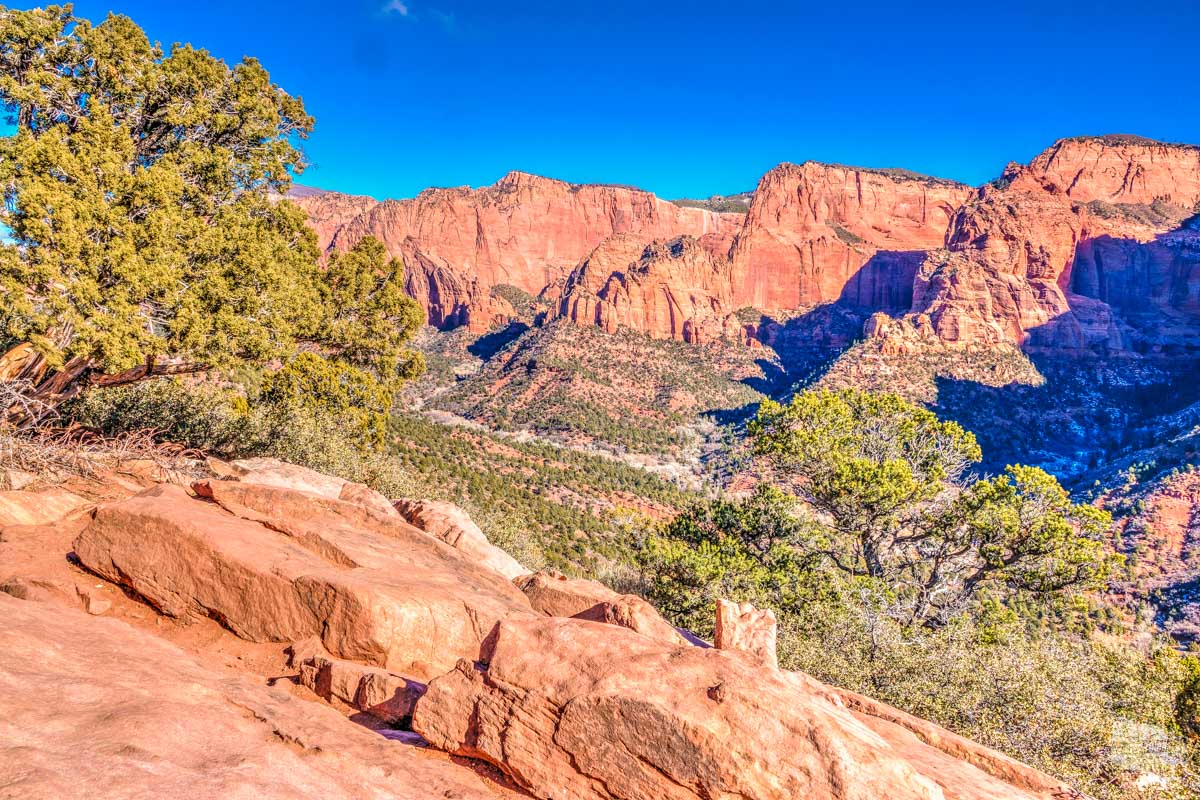
Just be sure to bundle up in the winter! Again, temperatures were lower and the ridge is quite exposed so you may have quite a bit of wind as well. Even with the cold, windy conditions we really enjoyed this short hike.
Taylor Creek Trail
The Zion Information Guide provides this description of Taylor Creek Trail: “Follows the Middle Fork of Taylor Creek past two homestead cabins to Double Arch Alcove.” The park Web site provides a better description, which we did not read ahead of time, that includes “Winter conditions can be very icy and water crossings in the spring will get your feet wet.”
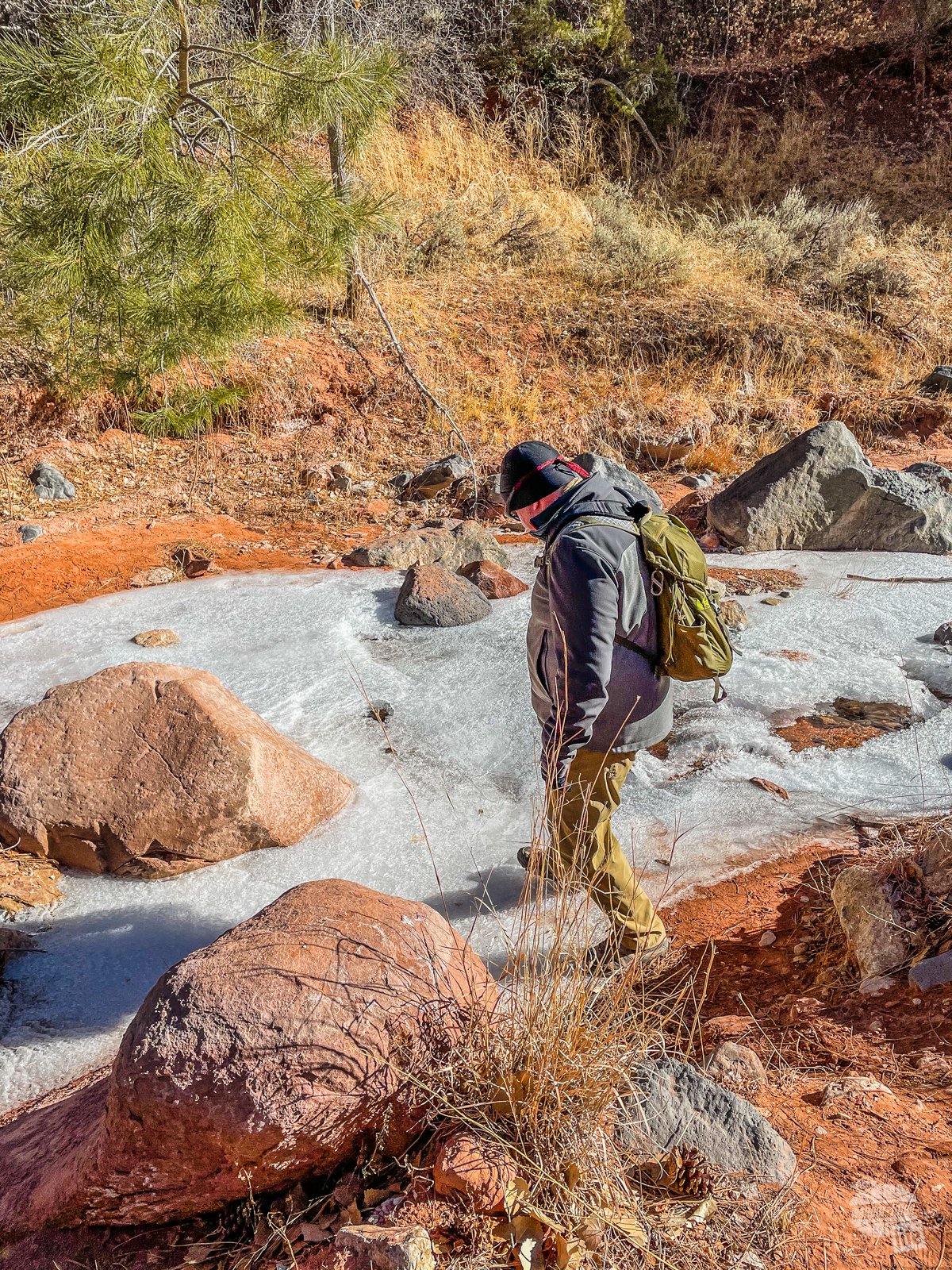
Overall, we really enjoyed this hike. We just weren’t prepared for crossing the creek roughly 20-30 times. Thankfully, the creek was mostly frozen. There were a couple of areas that were a bit tricky, though. And, Grant’s step did break the ice in one spot, leaving his foot wet and cold. That said, his SmartWool socks did their job and wicked the moisture away from his skin.
The two homestead cabins are located at about the first and second mile. The cabins are fairly basic. Still, we always enjoy finding remote cabins like these and considering what life would be like there. You can easily see why these folks chose to homestead here.
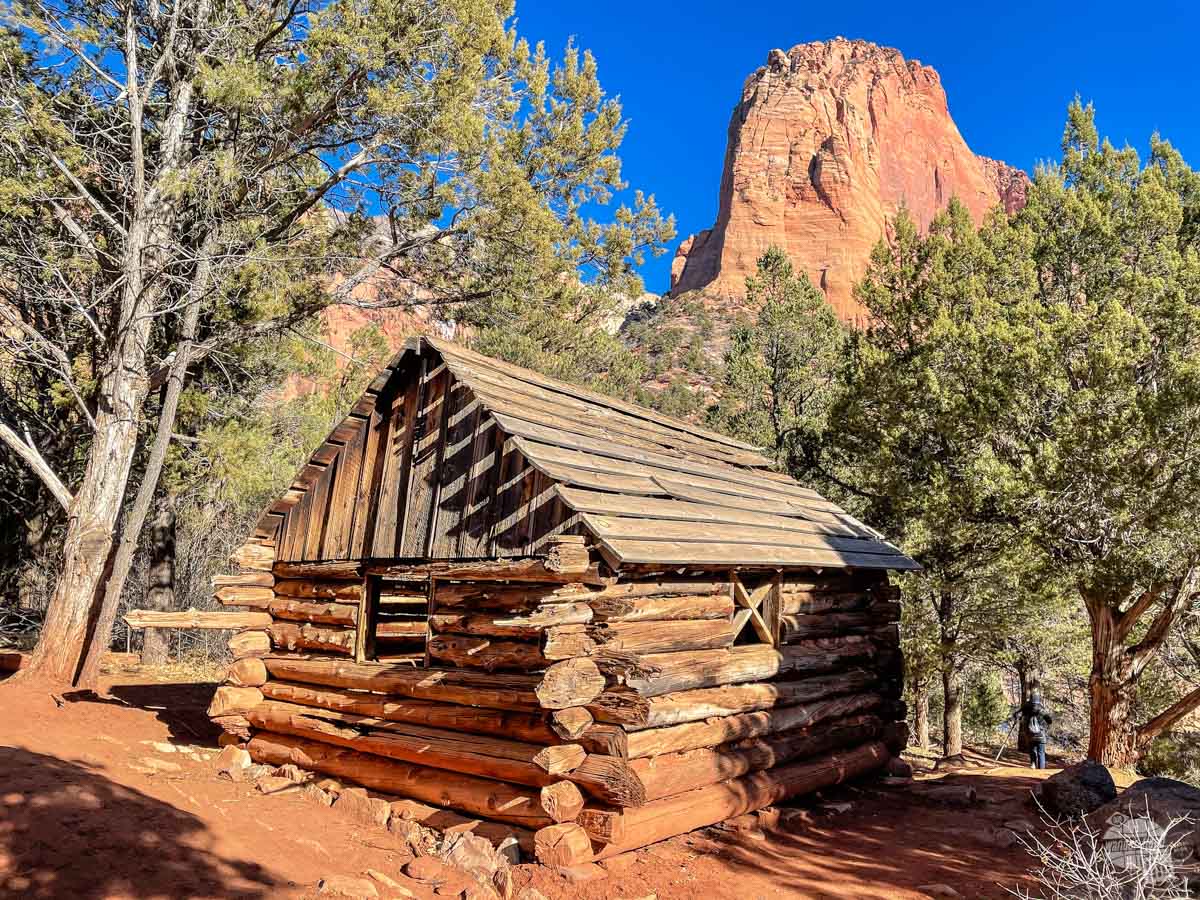
The trail ends at an interesting landscape known as Double Arch Alcove. Words really don’t accurately describe this feature, so I’ll let the picture speak for itself.
This 5-mile round trip trail does gain about 450 feet of elevation but most of it is gradual. The creek crossings were a bit interesting. Be prepared for icy conditions in the winter. And, if the creek isn’t frozen over, be prepared for your feet to get wet.
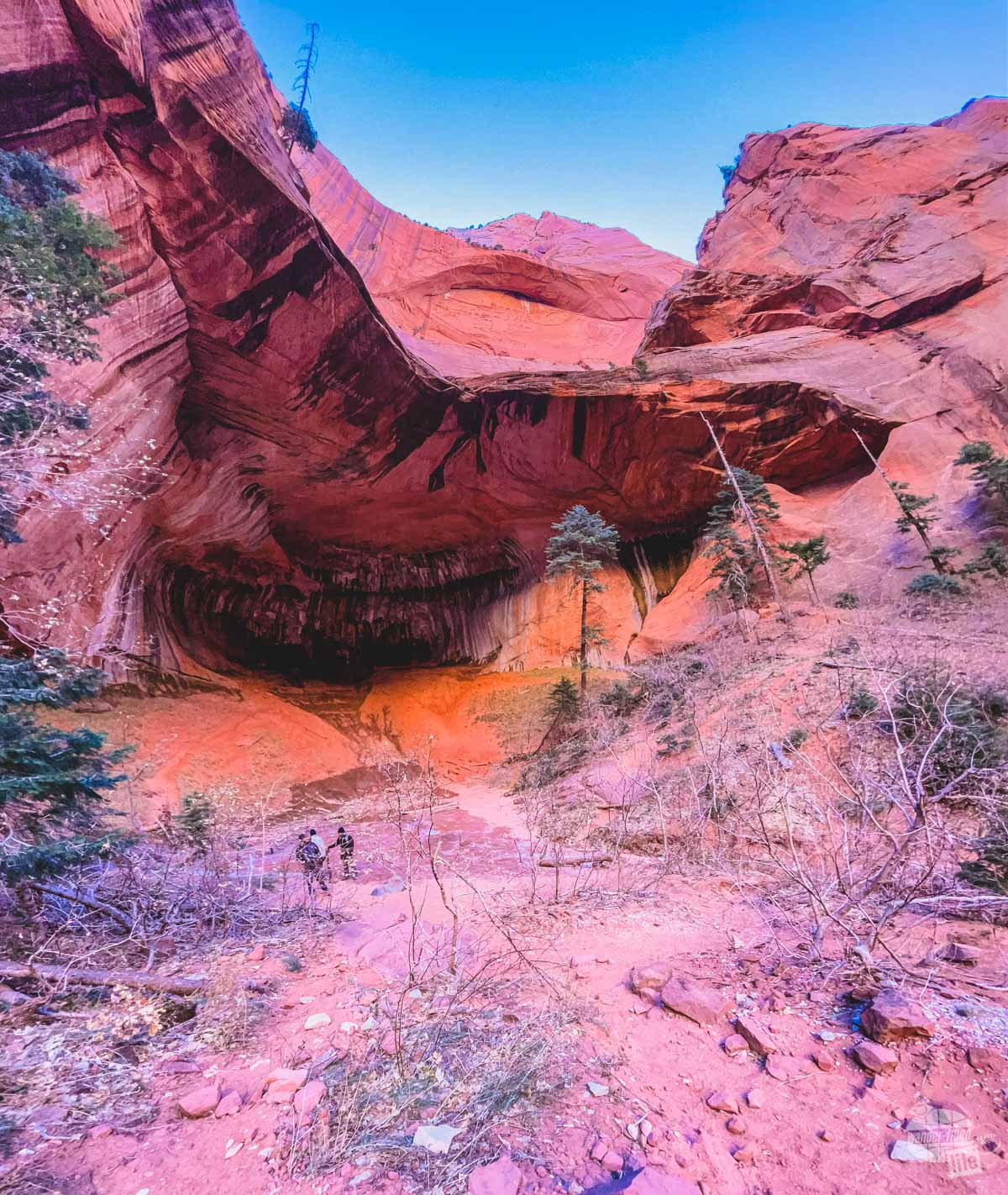
Kolob Terrace Road
The final area of Zion National Park is Kolob Terrace Road. This road starts about 10 miles west of the main entrance in Springdale. From Highway 9, it zigzags in and out of the park for about 20 miles. While this is a nice drive, it is not quite as scenic as other parts of the park.
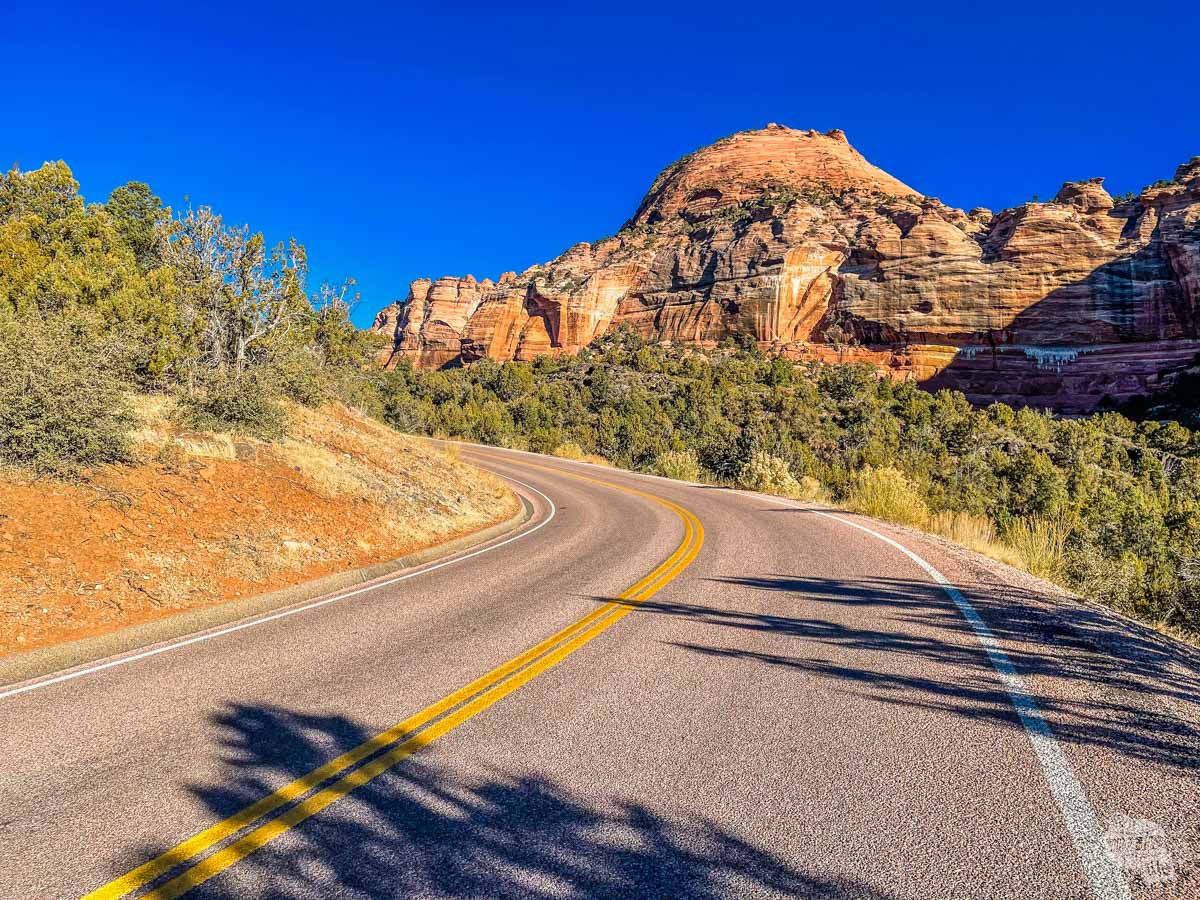
Still, it’s a fantastic place to escape from the crowds. There are a few trails along the road, but we did not hike any of them.
The highlight of our drive was a glimpse of some wildlife. We saw a few deer, most of whom were very shy. The real treat was a large herd of elk. Unfortunately, right as we saw them they took off running. Grant did his best to follow them and was able to get a few pictures.
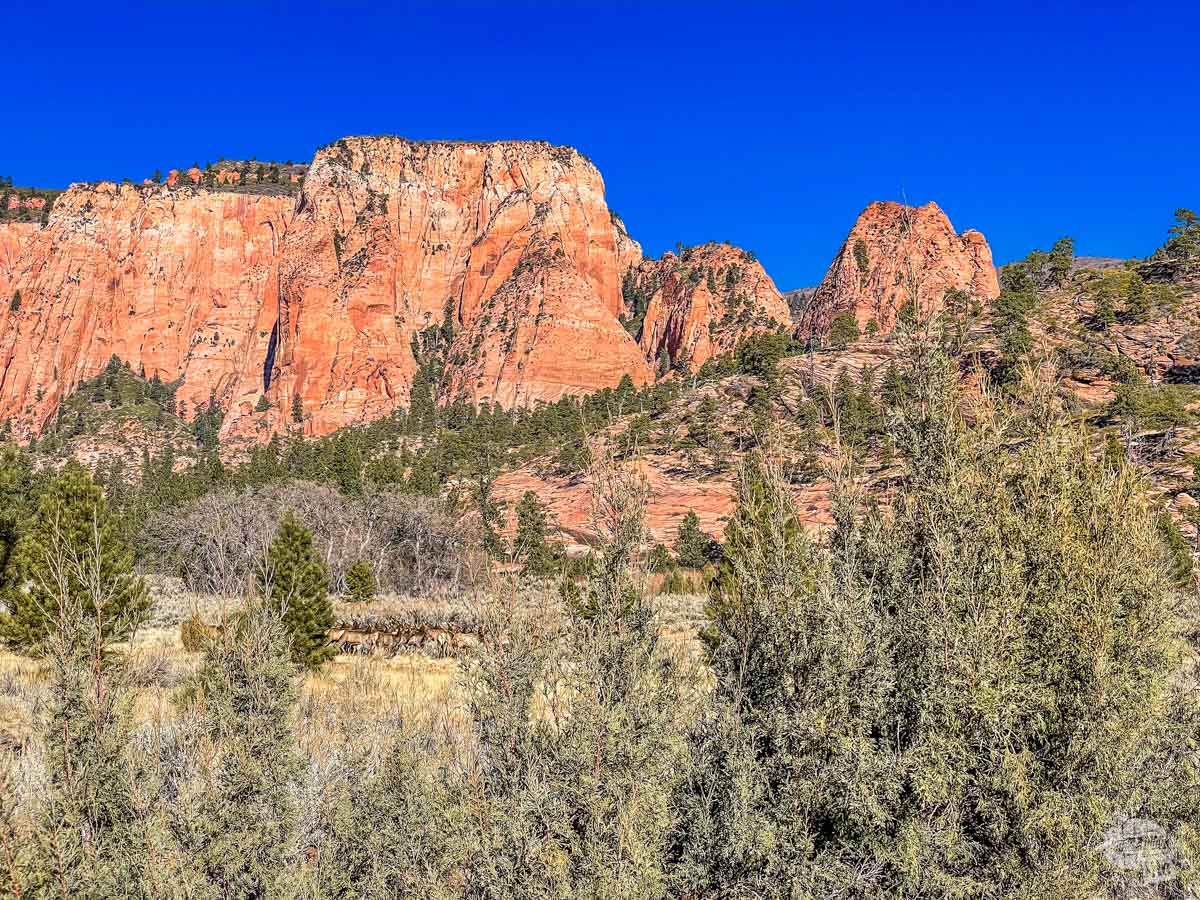
Portions of the road do close in winter, so check conditions, especially if you are interesting in getting to any of the hiking trails.
Where to Stay
You’ll find a good variety of hotels and campgrounds in Springdale, Utah. There are also a couple of campgrounds in the park, along with Zion Lodge. The one benefit to staying at the lodge would be that you can drive to it, even when the shuttle is in service.
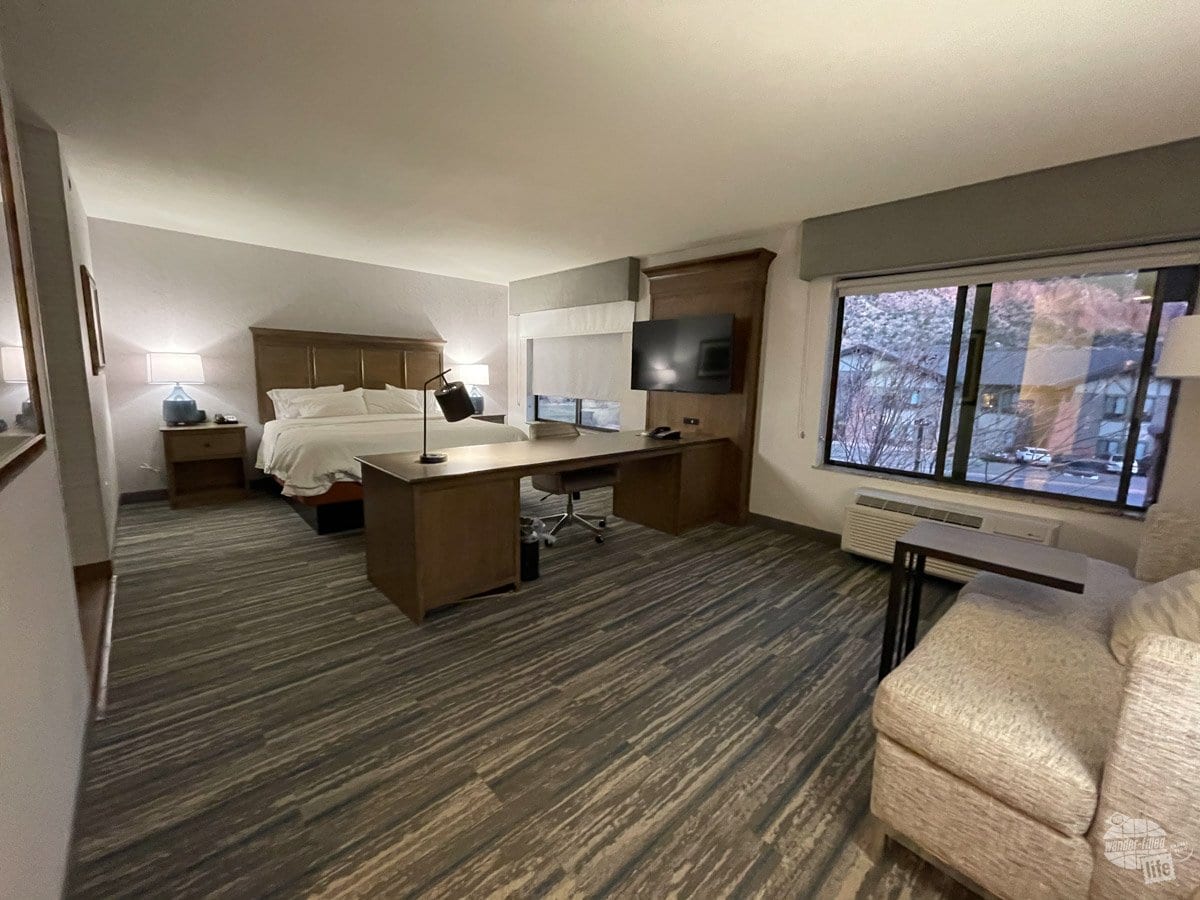
We chose to stay at the Hampton Inn & Suites. The hotel did a great job with breakfast during COVID-19 and was overall exactly what you’d expect from a Hampton Inn. For us, it was perfect.
Read TripAdvisor reviews | Book The hotel
Some places are closed in the winter, especially campgrounds. Still, there are quite a few good options year-round.
Where to Eat
For a small town, Springdale offers a good variety of restaurants, even in the winter. At the suggestion of the front-desk clerk, we headed to Oscar’s Cafe for dinner our first night. The menu focuses on Mexican dishes but includes salads, burgers and sandwiches as well.
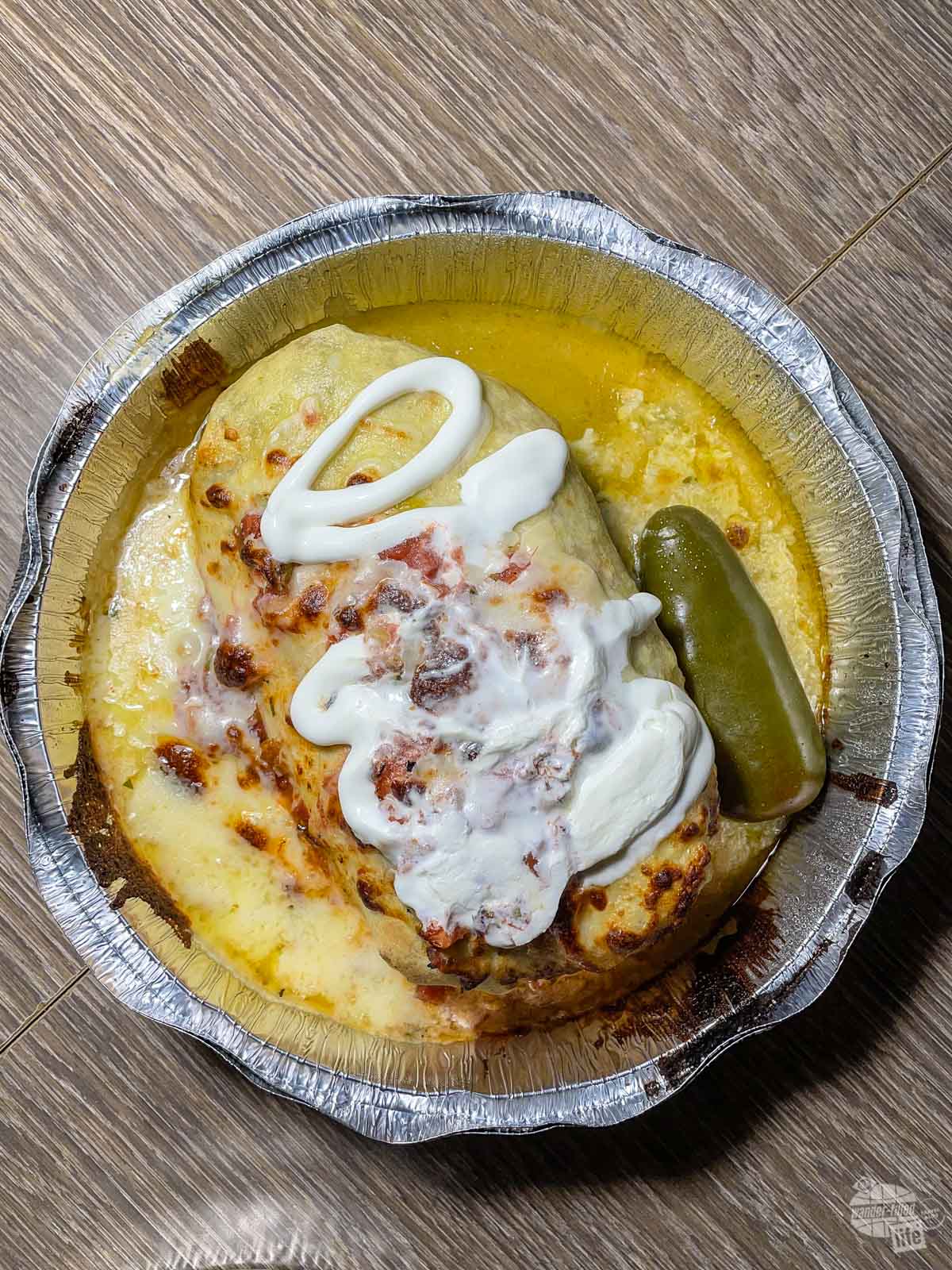
Since we were visiting during COVID-19, we chose to get a couple of burritos to go. The service was quick and friendly. And the burritos were huge! You can easily share or have enough for leftovers.
Our trips for traveling during the COVID-19 pandemic.
We also couldn’t pass up the Zion Canyon Brew Pub. You’ll find a good variety of beer and a typical pub menu of burgers, sandwiches and a few specialty entrees. We both enjoyed a burger (classic for me, an elk burger for Grant). For beer, we had the Juicy IPA and Echo Canyon IPA. Both were tasty but nothing super unique.
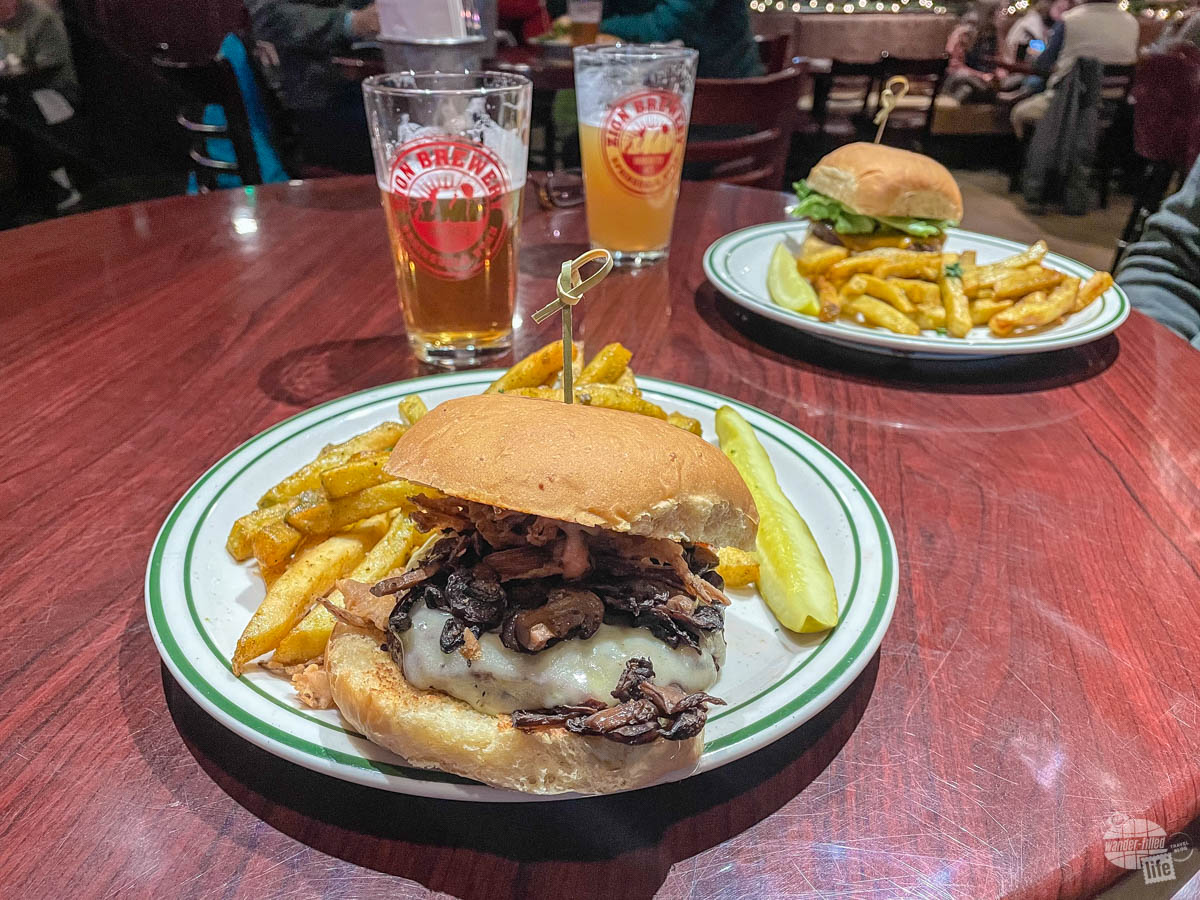
In addition to several good restaurant options, there is a good-sized grocery store in Springdale. You can easily pick up just about anything you’d expect to find at a grocery store. Prices are a little higher than average but not outrageous.
Final Thoughts on Zion National Park in the Winter
When planning a visit to Zion National Park in the winter, you really just have to be flexible. Seriously, very little of our visit went as we originally planned. And we didn’t even encounter any winter weather! But, winter weather can close trails and roads, at least temporarily so be sure to keep an eye on the forecast.
Get our tips for preparing for a winter road trip.
If the shuttle bus is not running, understand that the scenic drive in Zion Canyon will close once parking is full. In this case, you can easily visit another part of the park, which is what we did. Another option would be to head into town and look for a bicycle rental.
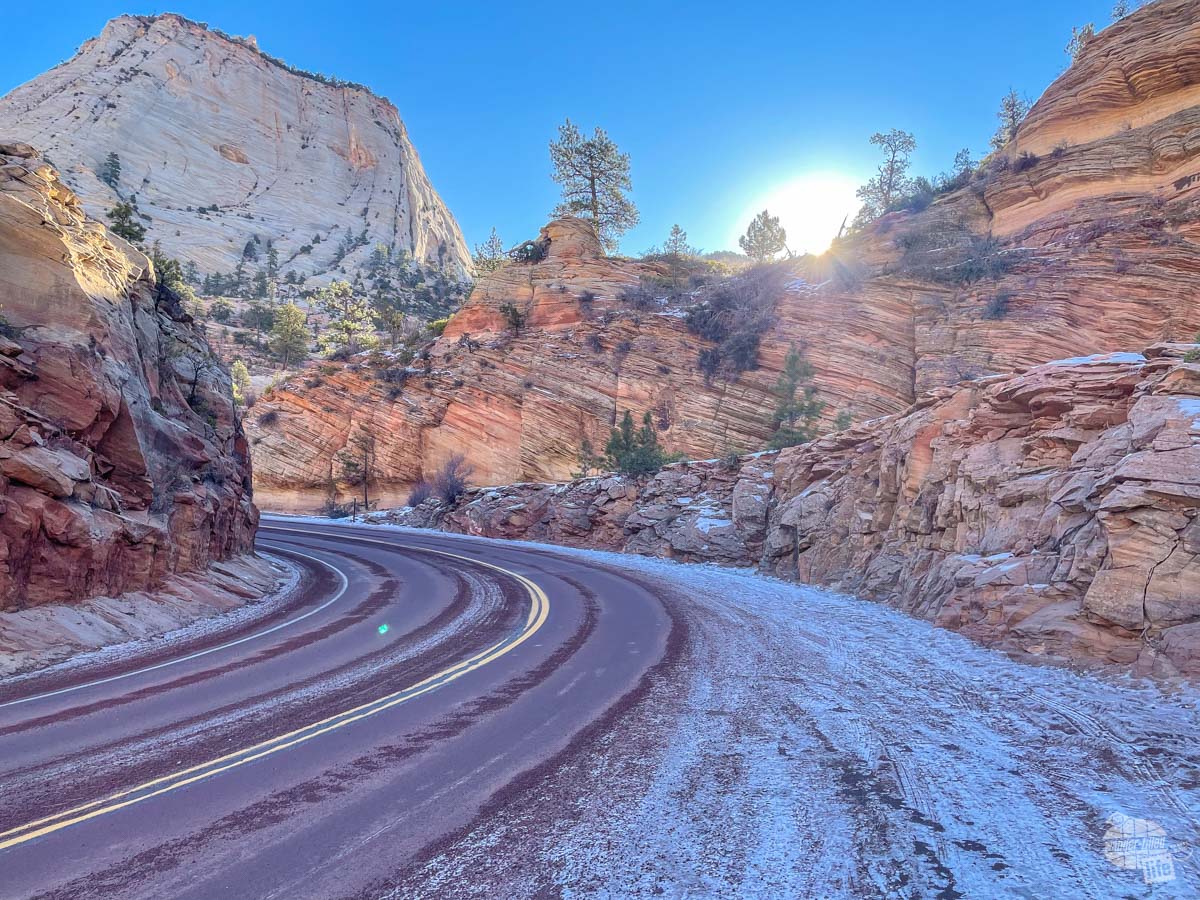
With cooler temperatures and smaller crowds, winter can be a great time to visit Zion National Park. We truly enjoyed our trip, even though we do plan to return at a warmer time of year to hike The Narrows.
My biggest suggestion, if you are a hiker, is to invest in some sort of guidebook. We got the feeling that there are plenty of hidden gems that weren’t advertised on the NPS website and brochures. Still, the scenery is amazing and you’ll find plenty of great things to keep you busy for at least 2-3 days.
Mostly, I encourage you to remember there is more to the park than just Zion Canyon. While that area is great, there are plenty of other things to see that are just as fantastic.
Travel Resources
What do you use to find a flight?
We use Skyscanner to find deals on flights. Skyscanner has a great interface and compares tons of airlines for the best pricing and routing. That said, it does not always have every airline and some airlines will have better deals on their website. Still, Skyscanner is a great place to start.
Click here to search for a flight.
What do you use to find a hotel?
We typically stay at Hilton properties, so we use the Hilton website. You can find good Hilton Honors discounts or AAA discounts for a hotel there. We make great use of our free night certificates from our Hilton Honors American Express.
Click here to book a Hilton property.
If there are no Hilton properties available, we use TripAdvisor to read reviews and book the hotel. We find we can get the best price that way.
Click here to search for a hotel.
We recently partnered with Stay22 to add interactive maps to each of our destination posts. This will allow you to see a plethora of hotels and vacation rentals all in one responsive map of the area.
What if I need more space than I can get at a hotel?
We use Vrbo for the times when we have rented a cabin for a weekend getaway, like this cabin in Townsend, TN, or needed to rent a house for a large family vacation. We had a great experience with them in terms of refunding deposits when COVID hit and will continue to use them.
Click here to search for a vacation rental.
Who do you use for rental cars?
As a general rule, we book with Hertz for rental cars. We have had nothing but good experiences with them. Plus, we really like unlimited mileage and not worrying about crossing state lines. We have even rented from Hertz overseas in both Slovenia and Croatia.
Click here to book a rental car.
How about booking a cruise?
We have found some amazing prices for booking a cruise through Cruise Direct. We have saved a lot of money on our cruises compared to what we found elsewhere, making a last-minute Bahamas cruise even cheaper.
Click here to book a cruise.
What if I want to rent an RV?
We highly recommend Outdoorsy for RV rentals. We rented a camper van for a week to visit Rocky Mountain National Park for the elk rut and Custer State Park for the Buffalo Round-Up and had a blast. The program was easy to use and we really enjoyed the freedom of having a camper van for that trip.
Click here to rent an RV.
What do you use for booking tours?
We don’t often book tours. Typically, we like to do stuff on our own. That said, there are some experiences you can’t have any other way. So, when we do want to book a tour, we always check Viator first.
Click here to book a tour.
Do you use anything to get discounts on the road?
We make extensive use of both Good Sam and AAA on the road. Good Sam is normally regarded as a discount card for RVers at campgrounds and Camping World but anyone can use the 5 cents off a gallon at the pump at both Pilot and Flying J.
Click here to get a Good Sam membership.
We have had AAA as long as we have been married and it has more than paid for itself in discounts at hotels, aside from the peace of mind of having roadside assistance. Add in paper maps and the ability to get an international driver’s license and it is more than worth it for any traveler out there.
Click here to get a AAA membership.





I have actually been seeking this all this time around.
Pleased I have discovered it here. Thank you so much!
Thanks so much!